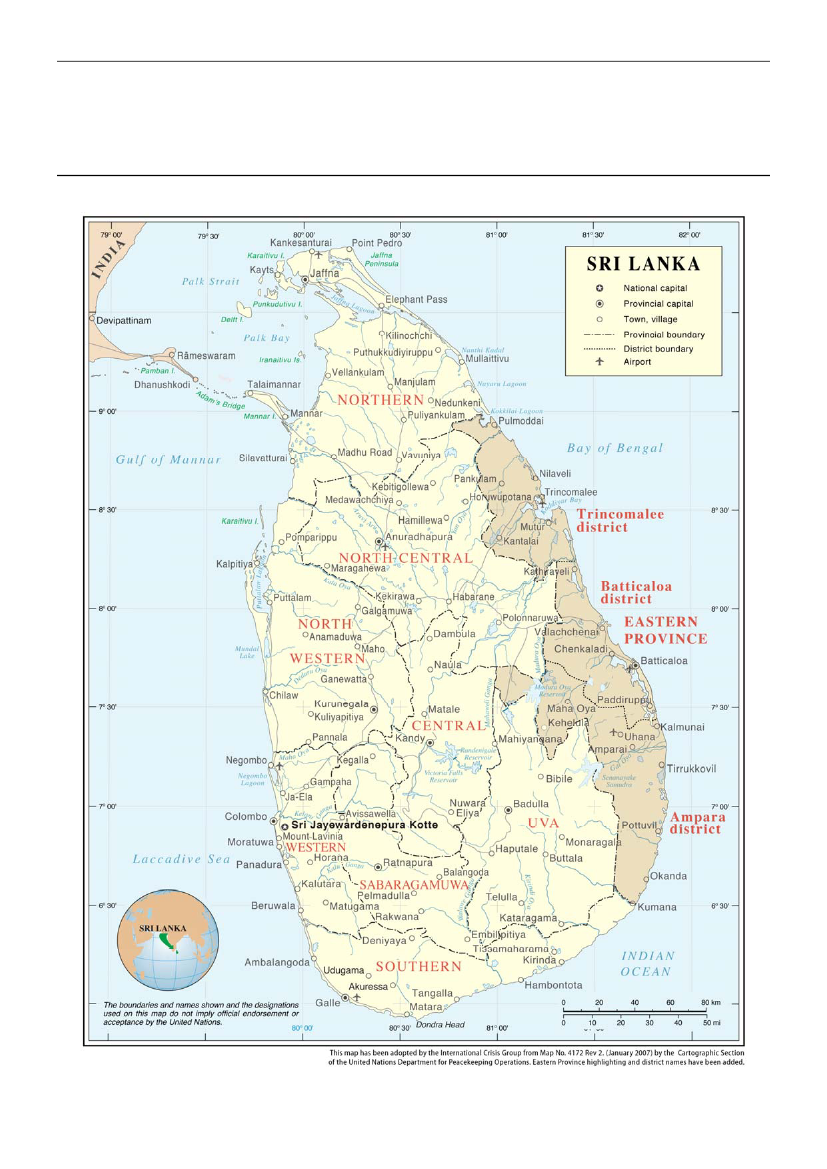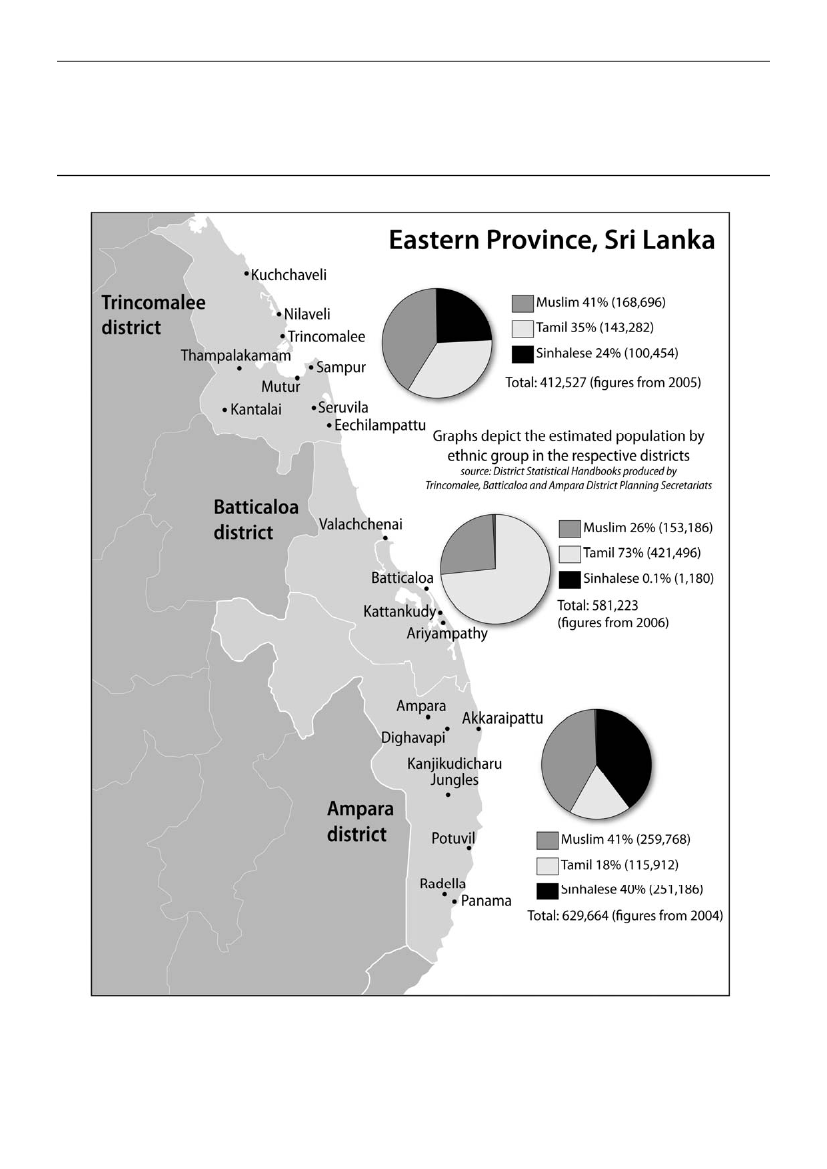Udenrigsudvalget 2008-09
URU Alm.del Bilag 153
Offentligt
DEVELOPMENT ASSISTANCE AND CONFLICT IN SRI LANKA:LESSONS FROM THE EASTERN PROVINCEAsia Report N�165 – 16 April 2009
TABLE OF CONTENTSEXECUTIVE SUMMARY AND RECOMMENDATIONS................................................. iI. INTRODUCTION ............................................................................................................. 1II. EASTERN REAWAKENING.......................................................................................... 1A. DONORACTIVITIES......................................................................................................................2B. DETERIORATINGSECURITY, INCREASINGUNCERTAINTY.............................................................31. Increasing violence and impunity ................................................................................................32. Devolution still on hold ...............................................................................................................53. Muslim and Tamil alienation .......................................................................................................54. Policy shift needed.......................................................................................................................6C. RISKS TO AND FROMDEVELOPMENTWORK.................................................................................6
III. “CONFLICT SENSITIVITY” AND THE POLITICS OF AID ................................... 7A. THELIMITS OF“CONFLICTSENSITIVITY” ....................................................................................7B. DONORHESITATIONS...................................................................................................................9C. PRINCIPLES OFENGAGEMENT....................................................................................................10
IV. MANAGING THE RISKS BETTER ............................................................................ 12A.B.C.D.E.F.G.ENGAGING THEPROVINCIALCOUNCIL.......................................................................................12RESPONDING TOINSECURITY ANDIMPUNITY.............................................................................13EXTORTION, THEFT ANDFRAUD................................................................................................15DISARMAMENT, DEMOBILISATION ANDREINTEGRATION...........................................................17CHILDSOLDIERS........................................................................................................................18ECONOMIC ANDBUSINESSDEVELOPMENT.................................................................................19THEQUESTION OFLAND............................................................................................................211. Land regulations and policies ....................................................................................................212. Road building.............................................................................................................................223. Housing ......................................................................................................................................234. Irrigation ....................................................................................................................................235. High security zones and special economic zones ......................................................................23H. CONFLICT-RELATEDDISPLACEMENT.........................................................................................24
V. CONCLUSION: LESSONS FOR THE NORTH ......................................................... 28APPENDICESA.MAP OFSRILANKA.........................................................................................................................30B.MAP OF THEEASTERNPROVINCE.....................................................................................................31C.GLOSSARY.......................................................................................................................................32D.ABOUT THEINTERNATIONALCRISISGROUP....................................................................................34E.CRISISGROUPREPORTS ANDBRIEFINGS ONASIA SINCE2006 .........................................................35F.CRISISGROUPBOARD OFTRUSTEES................................................................................................37
Asia Report N�165
16 April 2009
DEVELOPMENT ASSISTANCE AND CONFLICT IN SRI LANKA:LESSONS FROM THE EASTERN PROVINCEEXECUTIVE SUMMARY AND RECOMMENDATIONSViolence, political instability and the government’sreluctance to devolve power or resources to the fledg-ling provincial council are undermining ambitious plansfor developing Sri Lanka’s Eastern Province. The eastcontinues to face obstacles to economic and politicalprogress and offers lessons for development agenciesand foreign donors considering expanding their workinto newly won areas in the Northern Province. Whilethere is still potential for progress in the east, it remainsfar from being the model of democratisation and post-conflict reconstruction that the government claims.Donors should adopt a more coordinated set of policiesfor the war-damaged areas of Sri Lanka, emphasisingcivilian protection, increased monitoring of the effectsof aid on conflict dynamics and collective advocacywith the government at the highest levels.International attention is currently and rightfully focusedon the need to protect upwards of 100,000 civilians atrisk from fighting in the northern Vanni region, but atthe same time, there are still important challenges inthe so-called “liberated” area of the Eastern Province.Even now, the Eastern Province is still not the “post-conflict” situation that development agencies had hopedit would be when they started work there in late 2007and early 2008. Despite the presence of tens of thou-sands of soldiers and police in the east, the LiberationTigers of Tamil Eelam (LTTE) have proven able tolaunch attacks on government forces and on their rivalsin the Tamil Makkal Viduthalai Puligal (TMVP). Therehave also been violent conflicts between different fac-tions of the pro-government TMVP, and impunity forkillings and disappearances, many of them apparentlycommitted by government security forces and/or theirallies in the TMVP. Extortion and criminality linkedto the TMVP also remain problems. Insecurity and fearare undermining the ability of agencies and contrac-tors to implement projects.Violence between Tamils and Muslims has been keptto a minimum since June 2008, but tensions betweenthe communities over land and political power remainhigh, and there seems little prospect of reconciliationso long as current government policies remain in place.Tamils are largely alienated from the government, thanksto the heavy hand of government security forces andTMVP activities. Many Muslims feel threatened byTMVP control of the provincial council and what theysee as Tamil domination of the provincial administration.Both communities continue to suspect the governmenthas plans for large-scale “Sinhalisation” of the east.Sinhalese villagers, students, contractors and govern-ment employees have, in turn, been victims of violentattacks.The government still has not devolved power to theEastern Province, as required by the Thirteenth Amend-ment to the constitution, which established the provin-cial council system in 1987 in response to Tamil demandsfor regional autonomy in the north and east. The gov-ernor of the province, appointed by the president, isblocking the council’s initial piece of authorising leg-islation, and development planning and implementationcontinues to be run from Colombo and central govern-ment ministries. The government has yet to articulateany plans for a fair and lasting distribution of resourcesand political power that would satisfy all communities.In this environment, development of the east remainsaffected by the conflicts and threatens to exacerbatethem. Despite the need for development, there is a dan-ger of funds being wasted or misused. Donors shouldnot be treating the situation as a typical post-conflictenvironment. Instead, there is a need for additionalmonitoring and additional coordinated political advo-cacy. This is all the more important now that donorsare considering assistance for the reconstruction of theNorthern Province, once security conditions allow.Bilateral and multilateral donors need to work with thegovernment in a coordinated way and at the highestlevels to ensure that its policies provide for effectiveand sustainable development. This should include awritten agreement on basic principles, to be signedduring a high-level donor development forum and priorto the commencement of any new projects. The govern-ment should agree to provide the basic level of human
Development Assistance and Conflict in Sri Lanka: Lessons from the Eastern ProvinceCrisis Group Asia Report N�165, 16 April 2009
Page ii
security necessary to successful development work byending impunity for human rights violations and plac-ing its counter-insurgency campaign under strict legalaccountability.It should establish a political context conducive toaddressing the inevitable future conflicts over land anddevelopment in the north and the east by empoweringthe respective provincial councils to address develop-ment and security needs. In the north, this must beginwith free and fair elections that feature the full rangeof Tamil political parties and are conducted with inter-national monitoring. Independent representatives of allcommunities, including from opposition parties, shouldbe given a significant role in key development decisions.Finally, Tamils and Muslims need assurances that thereare no current plans for Sinhalisation – either of theeast or the north – and that demographic issues will bedealt with only through negotiation with independentrepresentatives of all three communities as part of asettlement of the larger conflict.At the same time, donors and development agencies needto establish stronger procedures to understand thepolitical dynamics in the east and in the north and tomonitor the effects and uses of their development pro-jects, so as to limit the risk that their assistance willaggravate existing conflicts or provoke new ones. Todo development right, it will have to be done slowly,carefully and with greater political investment. It willalso require additional staff and resources. Major donorsshould form a joint donor task force or monitoring unitto analyse current conflict dynamics in the east (andwhen possible, in the north) and develop the sharedprinciples for more “conflict-sensitive” work which thegovernment would be requested to adopt.For these efforts to work, development agencies needto defend the work of local and international non-governmental organisations more vigorously. Threatsand intimidation are crippling the necessary informationflows, and general insecurity undermines meaningfulproject monitoring and public consultation. Multilateraldonors in particular need to send strong messages tothe government that harassment and denial of visas tointernational humanitarian and development workersand intimidation of local NGOs and community activ-ists undermine their ability to do responsible develop-ment work and must stop.
RECOMMENDATIONSTo Japan, the World Bank, AsianDevelopment Bank, United Nations, U.S.,EU and Other Bilateral Donors:1. Meet to review all development assistance to SriLanka and agree on principles for equitable andsustainable development in the east and north, toform the basis of a formal memorandum of under-standing with the government, to be supported byan adequately funded monitoring process. The gov-ernment should be requested to:a) empower the Eastern – and once elected, theNorthern – Provincial Council to play a key rolein development decisions through maximisingthe devolutionary potential of the ThirteenthAmendment and allowing the councils to passenabling provincial-level legislation withoutobstruction from the president, governors orparliament;b) consult actively with independent community andpolitical leaders from the three ethnic commu-nities, including opposition parties, on all signifi-cant development initiatives in the north andthe east;c) offer assurances to Tamils and Muslims that thereare no government plans for Sinhalisation of theeast or the north and that demographic issueswill be dealt with only through negotiation withindependent representatives of all three communi-ties as part of a settlement of the larger conflict;d) provide basic security guarantees to the citizensof the north and east and adequate security fordevelopment work, beginning with a crackdownon the criminal activities of pro-governmentarmed groups, including the TMVP and theKaruna faction, and an end to disappearancesand killings associated with the government’scounter-insurgency campaign;e) guarantee free and fair provincial elections inthe north, with the full range of political partiesallowed to campaign safely and no party allowedto campaign while armed, with internationalobservers in place, and to be held only after themajority of displaced have returned home fromgovernment camps;f) provide a timetable for the prompt return homeof all those displaced from the north, and allowfreedom of movement for the displaced prior toreturn and full access for humanitarian organisa-tions to any displaced while they remain in camps;
Development Assistance and Conflict in Sri Lanka: Lessons from the Eastern ProvinceCrisis Group Asia Report N�165, 16 April 2009
Page iii
g) respect the right of donors to work with localand international NGOs of their choosing whowill be free from harassment and visa restric-tions; andh) reestablish the rule of law throughout the coun-try, beginning with the president’s activation ofthe Constitutional Council and the subsequentappointment of independent police, humanrights and judicial services commissions.2. Recognise that the Sri Lankan context is not a typi-cal post-conflict situation and pay special attentionto conflict dynamics that may arise through devel-opment work by:a) establishing a joint donor task force to reviewthe past two years of donor projects in the East-ern Province and study the political forces cur-rently affecting conditions for development workin the east and, when security permits and civil-ians have begun to be resettled, in the north.b) devoting increased resources for the ongoingand collective monitoring of the effects ofdevelopment projects on conflict dynamics,either through a joint donor task force or throughproviding additional staff to the existing DonorPeace Support Group;c) hiring additional conflict advisers, increasing thenumber of project reviews, and establishingregular provincial-level monitoring meetingson land-related policies, especially with regardto fears of Sinhalisation;d) engaging in high-level and coordinated lobby-ing in defence of the work of local and interna-tional NGOs, insisting as a condition of aid thatthey be allowed to play an active role in moni-toring and responding to conflicts over land anddevelopment in the north and the east; ande) undertaking a collective study to determine thenature and extent of extortion, theft and “taxa-tion” by armed groups and government securityforces in the north and east, increasing moni-toring of the issue, and sending strong messagesto the central government, the TMVP and pro-vincial politicians that every effort must be madeto end such practices and hold those involvedaccountable.3. Support the empowerment and effectiveness of theEastern – and eventually the Northern – ProvincialCouncil by:a) requesting the government grant them the nec-essary authority to negotiate projects directly withdonors, at least in those areas listed as provin-
cial and concurrent powers under the ThirteenthAmendment; andb) working to achieve maximum political consensusfor development projects by obtaining agreementfrom both the ruling coalition on the council andthe political opposition, and by encouraging theprovincial councils to give a meaningful roleto opposition parties and community leaders indevelopment and land-related decisions.4. Work together to monitor current land use patternsand policies in the east and north by:a) underwriting a study of the effects that planneddevelopment projects in the east and northmight have on land use and ethnic relations andhow to prevent land-related projects from exac-erbating conflict dynamics;b) linking further funding for housing, irrigation orrelated development projects to the government’sdrafting new and equitable land titling, distributionand dispute resolution policies through a trans-parent and inclusive process of consultation;c) working closely with the government and imple-menting agencies who build donor-funded housesto ensure that the proper land titles or permitsare issued; andd) monitoring for any encroachment or arrival ofsettlers in and around emerging commercial hubsand newly built or expanded roads.5. Support conflict-sensitive business development by:a) giving preference to local residents in both thecontracting and sub-contracting work done withdonor money and encouraging government andprivate investors to do the same; andb) actively seeking out Tamil and Muslim businessesthat might be interested in expanding into theeast, to offset the existing advantages of Colomboand Sinhala businesses.6. Insist on a collective basis that international stan-dards are respected at all stages of displacement byestablishing as a condition for development assis-tance the following minimum principles, to becommunicated to the government and to donors’implementing partners, with mechanisms for moni-toring compliance:a) unrestricted access to the displaced for all rele-vant humanitarian agencies and representativesof donor countries;b) guarantees of protection for internally displacedpersons (IDPs) and humanitarian workers, includ-ing the presence of the International Committee
Development Assistance and Conflict in Sri Lanka: Lessons from the Eastern ProvinceCrisis Group Asia Report N�165, 16 April 2009
Page iv
of the Red Cross at all sites where the militaryand police conduct security screenings;c) freedom of movement for IDPs once they havecompleted security screenings, with the displacedallowed to stay with relatives or host families;d) civilian authorities in charge of security atcamps and hospitals that house the displaced;e) immediate preparation for a safe and timelyreturn of IDPs to original homes or whereverthey wish to go, preceded by a rapid and inde-pendent study of the number and location ofmines in the north; andf) no support given to camps with a semi-permanent or permanent character.
of the Thirteenth Amendment, including all nec-essary authority to negotiate projects with donors,at a minimum in those areas listed as provincial andconcurrent powers under the Thirteenth Amendment,and the authority to prevent emergency powers, highsecurity zones (HSZs) or special economic zones(SEZs) from being used to seize land without localconsultation, accountability or compensation.11. Give Tamils and Muslims in the east and north con-crete assurances that land policies will be devisedthrough inclusive and transparent means and willnot be used as a tool to politically weaken theircommunities.12. Include the views of independent Tamil and Mus-lim political representatives and community lead-ers in development decisions in the east and northand make genuine efforts to ensure that all threecommunities in the east benefit fairly from govern-ment economic development, including the Kap-palthurai Industrial Development Zone, and theOluvil and Valachchenai fisheries ports.13. Cease using HSZs and/or SEZs to displace residentswithout being granted monetary compensation orthe right to effective legal challenge.14. Grant compensation to businesses in the east andnorth that have suffered damage from war and eth-nic violence and to those in the Eastern Provincewhose properties were looted during and after thefighting in 2006 and 2007.15. Enact preferential hiring and contracting policiesfor local residents for all development projects inthe east and north.16. Ensure that security restrictions which limit live-lihood options – eg, on fishing, cattle-grazing orwood-collecting – are kept to a minimum and thatwhen enforced they are applied in clear, consis-tent and non-arbitrary ways.
To UNHCR, UNICEF and the ProtectionUnits of Humanitarian Organisations:7. In the absence of a full-scale field presence for theUN Office of the High Commissioner for HumanRights, develop a plan for an extensive and coor-dinated network of protection offices in the northand east which can report on compliance with inter-national standards for the protection of the dis-placed and those resettled in their home villages.
To UNICEF:8. Strengthen monitoring mechanisms and report onany evidence of underage recruitment by all armedgroups, including pro-government groups otherthan the Pillayan and Karuna factions, and insistthat under any future “action plan”, UNICEF hasthe power of unlimited, independent inspection ofall camps and offices of both Pillayan and Karunafactions and has adequate staff to monitor compli-ance with all terms of the agreement.
To the Government of Sri Lanka:9. Negotiate an agreement with international devel-opment partners to provide the conditions neces-sary for sustainable and equitable development inthe Eastern and Northern Provinces, as outlined inrecommendations above.10. Grant provincial councils a strong degree of con-trol over land, in line with, or beyond, the terms
To the Eastern Provincial Council:17. Extend the deadline for registering land clams un-til the regulations have been rewritten to remove anyserious causes for concern expressed by represen-tatives of any of the three ethnic communities.
Colombo/Brussels, 16 April 2009
Asia Report N�165
16 April 2009
DEVELOPMENT ASSISTANCE AND CONFLICT IN SRI LANKA:LESSONS FROM THE EASTERN PROVINCEI. INTRODUCTIONSri Lanka has been in violent conflict for more thanthree decades. An estimated 85,000 people have died,most in fighting between the government and the Lib-eration Tigers of Tamil Eelam (LTTE). The LTTEwas largely defeated in the east of the country in 2007and is now trapped in a small area in the north, shield-ing itself behind more than 100,000 civilians. Thereis an urgent need to ensure that these civilians areallowed by the LTTE and the Sri Lankan governmentto leave this area through an extended humanitarianpause. But even as attention is focusing on that crisis,violence continues in the east, despite efforts at politi-cal and economic development.These efforts have been supported by the internationalcommunity, which has also pledged assistance to thenorth of the country after the LTTE is defeated. But ifthis assistance is handled in the wrong way, it risksexacerbating a complex conflict that is by no meansover. This report examines the way redevelopment hasbeen managed in the east and suggests lessons for thenorth, an area particularly devastated by war.This report is based on interviews across the east of thecountry throughout 2008 and the first three months of2009. These included meetings with Sinhalese,1Tamiland Muslim community leaders, local governmentofficials, local NGOs and activists. Crisis Group alsomet with a range of officials, diplomats and aid offi-cials in Colombo. The east remains a sensitive issuein Sri Lanka and given the environment of intimida-tion and violence and the almost complete impunityfor political killings, few people were willing to talkon the record.
II. EASTERN REAWAKENINGWithin days of the capture of the LTTE’s last easternmilitary camp in July 2007, the president and seniorofficials announced government plans for a “massive”development program for the east.2Known asNagen-ahira Navodaya,or “Eastern Reawakening”,3the pro-gram calls for industrial development and infrastruc-ture projects, ranging from power plants, roads, bridges,and water and sanitation improvements, to touristdevelopment and other private business initiatives.There are also projects to provide economic opportu-nities, build housing, and resettle and rehabilitate thosedisplaced by fighting in areas formerly held by theLTTE.The government is already claiming success in the east.Maintaining that “the key to peace is prosperity”,4itpoints to new roads and bridges throughout the prov-ince, the ongoing construction of an industrial parkand a coal power plant near Trincomalee harbour, fish-eries ports in Valachchenai and Oluvil, and expandedmineral extraction along the north coast of Trinco-malee district. New irrigation projects are planned, andthe government has announced a bumper rice cropdue to an additional 130,000 acres of land now undercultivation.5All but a small number of people dis-placed by fighting in 2006-2007 have now been reset-tled, housing is being built, and electricity, drinking
1
In everyday usage, Sinhala and Sinhalese are often interchange-able. In this paper, Sinhala will be used in all cases exceptwhen referring to the ethnic group as a collective noun, asin “the Sinhalese”.
For an analysis of the role of land and development in ethnicconflict dynamics in the east, see Crisis Group Asia ReportN�159,Sri Lanka’s Eastern Province: Land, Development,Conflict,15 October 2008. See also Crisis Group Asia Re-port N�134,Sri Lanka’s Muslims: Caught in the Crossfire,29 May 2007.3Nagenahira Navodayacan also be translated as “EasternRevival” or “Eastern Rejuvenation”. The government’s web-site detailing their development plans for the east is www.neweast.lk.4“Development work moves ahead in the East”, Secretariatfor Coordinating the Peace Process (SCOPP), 28 November,2008, at www.peaceinsrilanka.org.5“Bumper paddy harvest in the east”, Secretariat for Coor-dinating the Peace Process (SCOPP), 5 March 2009.
2
Development Assistance and Conflict in Sri Lanka: Lessons from the Eastern ProvinceCrisis Group Asia Report N�165, 16 April 2009
Page 2
water and social services are being provided to manyareas formerly under the control of the LTTE.6
A. DONORACTIVITIESThe government has estimated the cost of its easterndevelopment plans at $1.8 billion over four years. Withlittle money of its own to spend, the government hasbeen courting international investors and canvassingsupport from multilateral and bilateral donors.7Donorsand development agencies were initially cautious, con-tent to continue with programming already underwayin the east.8By mid-2008, however, especially in thewake of the Eastern Provincial Council elections inMay, donors have approved significant new levels ofaid. It is difficult to calculate the exact amounts offoreign humanitarian and development assistance tothe east, but more than $500 million has been com-mitted in loans and grants from 2007 onwards, notincluding large amounts of post-tsunami assistance.9In June 2008 the World Bank announced its new $900million Country Assistance Strategy for Sri Lanka for2009-2012. An estimated $300 million of this is sched-uled to be spent on projects in the north and east.10
Development work in the east will range from housingand livelihood support to village-level infrastructure,road building and support for irrigation and agricul-ture. The Asian Development Bank (ADB) is also activein the east, implementing new programs worth some$50 million, as well as ongoing projects. Under itsCountry Partnership Strategy launched in October 2008,the ADB is funding the rehabilitation of roads, thestrengthening of the power system, improvements towater and sanitation networks and a range of smaller-scale community infrastructure projects.11A variety ofUN agencies have projects in the east; the UN is nowshifting from the humanitarian relief it offered in 2006-2007 to “early recovery”, largely in line with the focusof other donors.12The Japanese government, traditionally Sri Lanka’s larg-est bilateral donor, has committed roughly $100 millionin grants and loans for ongoing projects in the east,including rural road development, rebuilding irrigationsystems, micro-finance, livelihood support to farmersand community-level businesses, demining and otherhumanitarian support.13Other bilateral donors, includ-ing France and the European Union (EU), are offeringsignificant support, including the final portion of money
“Development work moves ahead in the East”, Secretariatfor Coordinating the Peace Process (SCOPP), 28 November2008, at www.peaceinsrilanka.org. The large majority of theprojects listed by the Peace Secretariat as success stories areforeign funded and implemented.7The government’s 2009 budget contains no allocation forprojects associated withNagenahira Navodaya,and the gov-ernment’s finances are now under extreme pressure. It isnegotiating with the International Monetary Fund for a $1.9billion emergency loan. Crisis Group interviews, diplomatsand aid officials, Colombo, April 2009.8Significant amounts of money remained for rebuilding hous-ing, schools, hospitals and infrastructure destroyed in theDecember 2004 tsunami, and internationally funded recon-struction work continued during 2006 and 2007. Most butnot all post-tsunami funds have now been spent in the east.9The exact total of international aid dedicated for humanitar-ian and development work in the east is impossible to calculate,since figures made public by donors cover different periodsof time and often do not specify amounts being spent in specificdistricts or provinces. It is generally unclear what percentageof funds in a multiyear project remains to be spent. Informa-tion on funding for projects beyond 2009 is not available fromall donors. Nonetheless, based on figures provided by themajor multilateral and bilateral donors, between $500 mil-lion and $1 billion has been made available for work in theeast from 2007-2011.10“Country Assistance Strategy for the Democratic SocialistRepublic of Sri Lanka for the Period FY2009-FY2012”, TheWorld Bank, at www.worldbank.lk. See also “World Bank
6
says North-East projects progressing well”,Sunday Times,16 November 2008.11In addition, “In the north and east, ADB will implementongoing projects and small livelihood projects (providingrural finance, upgrading fishery harbors, providing chillingfacilities for milk, repairing minor irrigation tanks, support-ing the dairy industry, etc.), and will rehabilitate small-scaleinfrastructure (hospitals, schools, markets). ADB will alsocontinue to support training and skills development in thenorth and east”, p. 27. The ADB has some remaining fundsfor rebuilding houses damaged by the war and the tsunami.Crisis Group interview, ABD officials, March 2009.12Crisis Group interview, UN officials, Colombo, November2008. The UN Office for Project Services (UNOPS) and UNHabitat are completing post-tsunami housing and infrastruc-ture projects; UN Development Programme (UNDP) has atransition and recovery project that focuses on housing, roads,livelihoods and community-level peacebuilding; and the Of-fice of the High Commissioner for Refugees (UNHCR) con-tinues the humanitarian relief and protection work begunwith renewed war and displacement in 2006; the work of theOffice for the Coordination of Humanitarian Affairs (OCHA)is being phased out in the east.13This total does not include the cost of projects completedin 2007 and 2008, nor for projects planned for 2009 and on-wards that are not yet underway. So the actual figure for pro-jects in the east from 2007 to 2011 is likely to be two orthree times higher than this. Crisis Group interview, Japa-nese embassy official, Colombo, March 2009. The bulk ofJapanese support goes directly to the Sri Lankan govern-ment, though small grants are also made to NGOs.
Development Assistance and Conflict in Sri Lanka: Lessons from the Eastern ProvinceCrisis Group Asia Report N�165, 16 April 2009
Page 3
for post-tsunami reconstruction.14Support from the EUhas focused on road repair, housing, and income gen-eration and livelihoods support.15The U.S. Agency forInternational Development (USAID) has been particu-larly active in the east with a wide range of smaller butsymbolically important initiatives, working entirelythrough non-governmental and private-sector organi-sations rather than the government. Their “Economicand Social Transition” (EAST) strategy aims to support“the positive transformation in the Eastern Province”by “developing the regional economy, strengtheninglocal governance, and increasing citizen participation”.16For some development agencies, the east has seemed tooffer real opportunities for peacebuilding. In the wordsof one senior aid official in May 2008, “There’s nowa unique opportunity to stabilise the east. If we helpthem do it right in the east, it becomes a model fordealing with the north….We’re treating the east like apost-conflict situation, doing what we’d be doing in apeace process….While we might not have agreed 100per cent with the way the election was run or with notdisarming paramilitaries, we’re acting now to makethe most of the situation. The opportunity is now. Youcan’t afford to wait for the whole conflict to be settled”.17
While this was a minority opinion prior to the Mayprovincial council elections, it became the dominantposition among donors by mid-2008.18
B. DETERIORATINGSECURITY, INCREASINGUNCERTAINTYThe Eastern Province and its people need help rebuild-ing their lives and economic infrastructure, but devel-opment agencies need to be careful about how theyengage in the area. The peace and development “divi-dend” expected by many donors after the May 2008provincial council elections has so far not materialised.Instead, the risks facing such work have increased,especially in the final months of 2008 and early 2009.
1.Increasing violence and impunityThere has been a marked deterioration in the securitysituation since mid-2008, particularly in Batticaloa dis-trict. Political killings, enforced disappearances, attackson police and army outposts, robberies, extortion andother criminal violence have become daily occurrences.In a single 24-hour period in November 2008 eighteenpeople were murdered in Batticaloa district by differentgroups.19Fear among civilians, business people and thoseinvolved in development work is extremely high.20While it is difficult to determine responsibility forindividual attacks, a general picture of the sources ofviolence can be drawn. Much of the violence is aproduct of increasingly bitter conflict between mem-bers of the Tamil Makkal Viduthalai Puligal (TMVP),now led by Eastern Province Chief Minister S. Chan-drakanthan, better known as Pillayan, and supportersof TMVP founder and now government minister V.Muralitheran, alias Karuna.21The 18 October 2008 mur-
14
The French government has allocated $56 million for roadbuilding in the east. Most European donors, including theBritish, Germans, Swedes and Dutch, have significantlyreduced their bilateral aid, in part because Sri Lanka is nowconsidered a “middle-income” country and in part becauseof concerns about security and impunity for human rightsviolations. The German government has allocated over 65million euros for reconstruction and development of thenorth and east. Crisis Group interviews, diplomats and aidofficials, March 2009.15The European Commission spent roughly 80 million eurosin the east on post-tsunami projects and has some 70 millioneuros in funds still to disburse. This makes it one of the largestbilateral donors, after China and Japan. Its aid is implementedby the ADB, World Bank, UN agencies and international andlocal NGOs. Crisis Group interview, EC officials, Colombo,April 2009.16USAID, at http://srilanka.usaid.gov/country_strategy.php.USAID development assistance to the east since 2007 totalsnearly $45 million. The two main components of USAID’sprogramming are Supporting Regional Governance (SuRG)and Connecting Regional Economies (CORE). These willinclude training and financial support for business develop-ment and small-scale economic development and livelihoodsprojects, human rights and Tamil language training for po-lice, participatory governance training for newly elected localgovernment officials, and support for demobilised child sol-diers. A range of post-tsunami reconstruction projects werecompleted during 2008. Crisis Group interviews, USAIDofficials, Colombo, March 2009.17Crisis Group interview, senior development agency official,Colombo, May 2008.
Provincial council elections saw the victory of a coalitionof the TMVP, led by Pillayan, and various pro-governmentMuslim parties. After political wrangling between the presi-dent and Muslim politicians, who received the largest numberof seats on the council, Pillayan was named chief minister.See Crisis Group Report,Sri Lanka’s Eastern Province,op.cit., pp. 9-11.19“Sri Lanka: Human Rights Situation Deteriorating in theEast”, Human Rights Watch, 24 November 2008.20Crisis Group interviews, businessmen, NGO workers andcommunity activists, Batticaloa, March 2009.21The government’s peace secretariat has admitted that “kill-ings and abductions within [the TMVP] and between themand the LTTE take place....It is an unhappy situation, but onethat has not been engineered by anybody other than the par-ticipants themselves”. “The Human Rights Watch Syndrome”,Secretariat for Coordinating the Peace Process (SCOPP), 26November 2008. For more on the activities of the Pillayan
18
Development Assistance and Conflict in Sri Lanka: Lessons from the Eastern ProvinceCrisis Group Asia Report N�165, 16 April 2009
Page 4
der of Pillayan’s most important adviser, Kumaras-wamy Nandagopan, was a major blow; while the gov-ernment blamed the attack on the LTTE, Pillayanhimself hinted at other sources.22Karuna’s decision inMarch 2009 to leave the TMVP and join PresidentMahinda Rajapaksa’s Sri Lanka Freedom Party (SLFP)has transformed but not ended the conflict.23TMVPcadres from both the Pillayan and Karuna factions arealso widely accused of criminal activities, includingextortion, abductions and killings.24The second halfof 2008 and early 2009 have also seen a growingnumber of LTTE attacks in the east, both against theTMVP, including some apparently successful attemptsto infiltrate TMVP offices, and against the police, armyand civil defence personnel.25Finally, there is credi-ble evidence to suggest that many of those killed aretargeted by the TMVP and government security forcesas LTTE members or supporters, either as part of thegovernment’s general counter-insurgency strategy orin response to specific LTTE attacks on, or infiltrationof, the TMVP.26
Coming from multiple and often uncertain sources, thecurrent violence is terrifying. “Previously, when theLTTE was stronger, we knew what the survival strate-gies were”, says one businessman in Batticaloa. “TheLTTE was predictable and disciplined. With the army,you were okay if you were not directly involved withthe LTTE. But now, it’s hard to predict. I’m havingtrouble knowing what to do to survive”.27While the large majority of the civilian victims havebeen Tamils, Sinhalese and Muslims have also beentargeted. On 21 February 2009, the Sinhala village ofKarametiya was attacked by an armed group pre-sumed to be LTTE; sixteen were killed and anotherten injured.28Three Sinhala construction workers wereshot to death in Kokadicholai, in Batticaloa, on 20October 2008.29Attacks on Sinhala farmers in theSeruvila area in Trincomalee district attributed to theLTTE have led to reprisal killings of Tamils in neigh-bouring villages.30There have also been a number ofviolent attacks on Muslims and altercations betweenMuslims and police and security forces.31
and Karuna factions in the Eastern Province, see Crisis GroupReport,Sri Lanka’s Eastern Province,op. cit., pp. 14-17, 19-20.22Chris Kamalendran, “Pillayan says LTTE not involved”,Sunday Times,16 November 2008.23After months of being the clear favourite of the centralgovernment, Karuna formally left the TMVP and joined theruling Sri Lanka Freedom Party (SLFP) in a public ceremonyin Colombo with the president on 9 March, where Karunawas named minister for national integration and reconcilia-tion. “Ex-rebel made Sri Lankan minister”, BBC News, 9March 2009. The Ampara area TMVP leader and the presi-dent’s district coordinator, Inyabarathy, also joined theSLFP. So, too, did 1,500 other people, many of them bussedto Colombo on orders of Karuna without being told theywould be joining the SLFP. TMVP offices under the controlof Karuna’s faction are now being converted to SLFP offices.His cadres remain armed. Crisis Group interviews, commu-nity leaders, Batticaloa, March 2009.24The March 2009 abduction and murder of a six-year-oldgirl in Trincomalee was attributed to TMVP members loyalto Pillayan. Karuna’s faction has been using the public out-rage over the murder to weaken public support for Pillayan.Jamila Najmuddin, “TMVP denies involvement in Varsha’smurder”,Daily Mirror,18 March 2009.25Karuna himself has admitted that the LTTE poses a seriousthreat in interior sections of the east. See Jamila Najmuddin,“Life in the East, a far cry from normal”,Daily Mirror,10December 2008. Others argue that fighting within the TMVPwas due in part to disgruntled members of the TMVP carry-ing out assassinations for the LTTE as a pre-condition to re-joining the rebels. “Ticking time-bomb in the east”,TheIsland,16 November 2008.26One particularly disturbing case that received some public-ity was the discovery of the mutilated bodies of two Tamilmen who had a few days earlier been seen in police custodyin Batticaloa. The police claim the men had been released
in good condition prior to their murder by unknown parties.“Sri Lanka: Human Rights Situation Deteriorating in theEast”, Human Rights Watch, op. cit. Arguments in civil suitagainst the police are due to be heard before the SupremeCourt in June 2009.27Crisis Group interview, businessman, Batticaloa, Novem-ber 2008. “Current power dynamics in the east are very fluid.People barely know who is in charge today; they could getkilled tomorrow for what is OK to do today”. Crisis Groupinterview, donor official, Colombo, December 2008.28Jeevani Pereira, “Hunger and fear reign in Karametiya”,Daily Mirror,25 February 2009. Karametiya is located onthe outskirts of the Gal Oya National Park, in Ampara dis-trict. With the 3 April killing of thirteen suspected Tigers inAmpara, the government claims to have successfully trackeddown and eliminated the small band of LTTE fightersblamed for this and other attacks in the east. Norman Pali-hawadena, “STF ambush kills 13 Tiger killers on the prowl”,Island,4 April 2009.29Senaka de Silva, “Three killed in Kokkadicholai”,DailyMirror,22 October 2008. The 21 August 2008 murder ofone of a small number of Sinhala students at Batticaloa’sEastern University led to the transfer of all Sinhala and Mus-lim students from the eastern campus. The 16 November2008 killing of a Sinhala doctor working at the Navatkudahospital in Batticaloa district forced the temporary with-drawal of all Sinhala government doctors from the east.Jamila Najmuddin, “Life in the East, a far cry from normal”,Daily Mirror,10 December 2008.30Senaka de Silva, “Farmers killed by suspected Tigers”,Daily Mirror,26 March 2009.31In one incident in August 2008, 28 Muslims collectingfirewood in the forests near Potuvil, in Ampara district, werearrested on charges of supplying provisions to LTTE fighters.One of the firewood collectors died in custody, allegedly due
Development Assistance and Conflict in Sri Lanka: Lessons from the Eastern ProvinceCrisis Group Asia Report N�165, 16 April 2009
Page 5
The near-complete impunity for killings and disappear-ances adds to the widespread fear. Many survivorschoose not to report cases of disappearances, robbery,extortion, sexual violence and other criminal attacksgiven the unwillingness of the police to seriouslyinvestigate; in many cases, police even refuse to acceptcomplaints. “Everyone is too scared to complainabout anything”, explains a human rights lawyer. “Noone wants to file legal actions or police complaintsabout any issue at all because the person they areangry with may be linked to an armed group and seekretribution”.32There is still no evidence of any seriousinvestigations into political killings and disappearancesover the past few years.
to be made by the central government, operatingthrough the governor and the nation building minis-try, which is effectively controlled by presidential ad-viser Basil Rajapaksa.36Both the Eastern ProvincialCouncil and development agencies complain of politi-cal interference with their work.37A bright spot is that the lack of central governmentsupport for the Eastern Provincial Council has pro-duced a certain degree of common ground betweenthe council’s ruling TMVP-Muslim coalition and theopposition coalition of the United National Party(UNP) and the Sri Lanka Muslim Congress (SLMC).All parties would like to see the provincial councilassume the full range of powers granted, in principle,by the Thirteenth Amendment.
2.Devolution still on holdDespite the government’s public commitment to imple-menting the Thirteenth Amendment, which establishedprovincial councils with limited devolved powers,there has yet to be any real devolution to the EasternProvincial Council.33Nor have any powers over landor taxation been transferred to the council. Indeed, thegovernor of the province, a retired general appointedby and working closely with the president, has pre-vented implementation of the provincial council’s firstlegal statute, which would formally establish its pow-ers of limited taxation.34Otherwise the council remainsentirely dependent on the central government for itsfunding; in early 2009 the council was reportedlybankrupt.35Policy decisions about development work and impor-tant political matters in the Eastern Province continue
3.Muslim and Tamil alienationMany Muslims continue to feel vulnerable to attacksand extortion from the TMVP and, to a lesser extent,from government security forces. Tensions betweenTamils and Muslims, aggravated by the actions of thePillayan and Karuna factions, remain high.38Manyremain bitter over the nomination of Pillayan, ratherthan the Muslim candidate Hisbullah, as provincialchief minister and complain that Tamils continue tocontrol the provincial administration and council.39Few Tamils, on the other hand, express satisfactionwith the limited benefits they receive from having aprovincial council controlled by the TMVP. Most con-tinue to see the TMVP as a dangerous and parasiticforce on the community. Many also believe Muslimscontinue to have more political influence and betteraccess to resources. And virtually all Tamils complainof repressive government security policies and fearexpanded government-sponsored Sinhalisation. The con-tinued displacement of more than 5,000 Tamils fromtheir homes in the government’s Sampur High Secu-rity Zone in Trincomalee is a major source of alien-ation40and has fed fears that more such high-security
to police abuse. 26 of the suspects were convicted and sen-tenced to a year in prison in February 2009. “26 PottuvilMuslims sentenced to imprisonment”, Peace Secretariat forMuslims, 10 February 2009, at www.peacemuslims.org.32Crisis Group interview, human rights lawyer, Batticaloa,November 2008.33The government announced in November 2008 that a “highlevel three-member committee” would be formed to devolvepower to the east in terms of the Thirteenth Amendment to theconstitution. There has been no further news about its activi-ties. P. Krishnaswamy, “Three-member committee to devolvepower to the East”,Sunday Observer,30 November 2008.34M.M. Abdul Kalam, “Governor is obstructing devolutionof power to Eastern Provincial Council”,Federal Idea,6January 2009, available at http://federalidea.com/fi/2009/01/post_90.html.35Crisis Group interviews, donors and diplomats, Colombo,March 2009. See “EPC languishing without funds”,DailyMirror,17 January 2009. According to the article, the coun-cil is “facing a severe financial crisis as only Rs.200 millionout of a total allocation of Rs.836 million had been receivedby the council which even had no funds to pay staff salaries”.
The nation building ministry is represented in the east byMinister Susantha Punchinilame, who has established an of-fice in Trincomalee and is said to be closely monitoring, andinterfering with, the work of the provincial council. CrisisGroup interviews, government officials, Trincomalee, No-vember 2008.37Crisis Group interviews, diplomats and development offi-cials, Colombo, November 2008 and February 2009.38Crisis Group interviews, NGO workers and communityleaders, Batticaloa, March 2009.39Crisis Group interviews, politicians and community lead-ers, Kattankudy, November 2008.40This is a government figure, as reported by UNHCR. CrisisGroup interview, Colombo, March 2009. A longer discussion
36
Development Assistance and Conflict in Sri Lanka: Lessons from the Eastern ProvinceCrisis Group Asia Report N�165, 16 April 2009
Page 6
zones linked to economic development could be in thepipeline.41There is some evidence that the LTTE isable to operate more effectively in the east due in partto the growing alienation of Tamils from the govern-ment and their designated government-sanctioned rep-resentatives, the TMVP.42
C. RISKS TO AND FROMDEVELOPMENTWORKWithout such a significant shift in policy, developmentwork in the east will continue to face, and to pose,serious risks.Increased violence has already taken the lives of devel-opment workers and threatens the successful completionof projects. Complaints about extortion from variousfactions of the TMVP and unidentified criminal groupsare also common, in Batticaloa especially. Extortionscares away potential entrepreneurs and provides sup-port to violent and unaccountable armed groups.There are also longer-term political and social risksfrom the pursuit of development in a violent and mili-tarised context, where political decisions are madewithout meaningful public consultation. In the absenceof fair and inclusive decision-making processes, dis-putes over the distribution of land, economic oppor-tunities, and government benefits and resources aremore likely to take on an ethnic colour and turn violent.The political stability of the east has long sufferedfrom precisely these sorts of conflicts. Violent dis-putes between Tamils and Muslims have been kept toa minimum since the provincial council elections, butdeep tensions remain.44The central government has donelittle to foster dialogue and reconciliation between thetwo communities.The most widely discussed risk from development pro-jects is state-sponsored Sinhalisation. As donors anddevelopment agencies recognise, fears of Sinhalisationare widespread among Tamils and Muslims in the eastand undermine the trust necessary for sustainabledevelopment. Understood as a process whereby economicdevelopment either directly or indirectly brings inenough new Sinhalese to alter the demographic balanceof particular districts or of the province as a whole, nomajor Sinhalisation has yet taken place. Nonetheless,the powerful influence of the almost entirely Sinhalamilitary over civilian affairs in the province, the lackof transparency with which development decisions aremade, the role of the government ally and Sinhalachauvinist Jathika Hela Urumaya in supporting the
4.Policy shift neededDespite the large number of internationally-financedprojects underway in the east, the government’s prom-ises of “demilitarisation, democratisation, developmentand devolution”43have yet to be realised. Projectshave been undertaken with little transparency or pub-lic consultation and in an insecure and militarised con-text. This undermines much of their positive potential.The east today has all the ingredients for continuedinsurgency and counter-insurgency: a virtually power-less provincial council, a divided TMVP, insecureMuslims, alienated and restless Tamils, growing divi-sions within ethnic communities and political parties,and continued violent repression of dissent.Opportunities for political stability and sustainabledevelopment in the Eastern Province have little chanceof being realised without a major change in how theeast is governed. This should begin with the govern-ment enforcing the law and providing basic securityguarantees to its citizens. This will require crackingdown on the TMVP and Karuna’s faction and curbingthe excesses of the government’s counter-insurgencycampaign. The government must assure Tamils andMuslims that there are no plans for the Sinhalisationof the east. The Eastern Provincial Council must beempowered to play a key role in development deci-sions. The government should begin to share power inother ways and include the views of independent Tamiland Muslim political representatives and communityleaders in its development decisions in the east. Solong as it refuses to do so, the “development” of theeast – and soon of the north – will continue to feelthreatening to many Tamils and Muslims and its posi-tive potential for fostering trust and ultimately recon-ciliation between communities will be lost. It will bemerely “victor’s development”, possibly paving theway for future violent conflict.
of displacement in the east and north can be found below inSection V.H.41Crisis Group interviews, government officials and commu-nity leaders, Trincomalee, November 2008; Colombo, March2009.42Crisis Group interviews, government officials and com-munity leaders, Batticaloa and Colombo, March 2009.43N. Ram, “We are firmly committed to a political solution:President Rajapaksa”,The Hindu,27 October 2008.
Violent clashes in May and June 2008 between Tamilsthought to be members of the TMVP and Muslims in Kattan-kudy and Batticaloa left more than a dozen dead. See D.B.SJeyaraj, “The killing of T.M.V.P. leader Shantan in Kaathaan-kudi”,Tamilweek,31 May 2008. An explosion opposite theHusainiya mosque in Kattankudy left five wounded on 25October 2008. “Hand grenade explosion at a mosque inKattankudy, five injured”,Muslim Guardian,26 October2008, available at www.muslimguardian.com.
44
Development Assistance and Conflict in Sri Lanka: Lessons from the Eastern ProvinceCrisis Group Asia Report N�165, 16 April 2009
Page 7
redevelopment of Buddhist sites in the east – theseand other factors lend some credence to fears of Sin-halisation.45To date, the government has made noserious attempt to reassure Tamils and Muslims in theeast that their fears are unfounded.Less noticed by donors is the risk that “development”will involve the economic takeover or de facto coloni-sation of the east by Sinhala business interests fromColombo and other parts of the country, in some casesworking in partnership with foreign investors. This isa realistic danger given the disproportionate degree ofpolitical control that Sinhala politicians and adminis-trators have over the east.In addition, continuing large-scale military presence andsecurity restrictions almost guarantee that economicopportunities will be distributed unequally, with Sin-halese granted more freedom than Tamils and Muslims.This can already be seen in existing fishing restric-tions and in the many stories of restrictions placed onrock-cutting, cattle grazing, firewood gathering andother livelihood opportunities traditionally available toTamils and Muslims in the east. Members of any ethnicmajority which largely controls the state are almostcertain to benefit disproportionately from economicdevelopment unless there are countervailing forces atwork: a strong political force representing minorities,a strong system of legal protections, or outside moni-toring and protection. None of these exist today.
III. “CONFLICT SENSITIVITY” ANDTHE POLITICS OF AIDA. THELIMITS OF“CONFLICTSENSITIVITY”The deteriorating security situation and lack of politi-cal reform in the east has begun to worry many donorsand development agencies. There is no talk yet ofsuspending work or withdrawing, but there is growingconcern that political instability in the Eastern Prov-ince is putting the government’s development plans atrisk and posing challenges to donor-funded projects.In the words of one donor active in the east, “We arefairly unhappy with how things have turned out in theeast and the commitments not honoured by the gov-ernment”.46Nonetheless, even as development agencieshave grown more willing to acknowledge the risksfrom and to their work, many argue their “conflictsensitivity” policies ensure they can be managed to atolerable degree.47“Conflict-sensitive development”, as understood bymost development agencies working in Sri Lankanow, involves five basic components:
targeting assistance to conflict-affected populationsand their conflict-related needs. In this vision, eco-nomic development can reduce sources of conflictin the east by improving people’s lives and reducingthe gap between the prosperous Sinhala-majorityWestern Province and the Tamil- and Muslim-majority east;48ensuring that benefits and resources are “spreadfairly across districts and across different ethnicgroups” so that aid to one community does not fuela sense of grievance among another;49
For an analysis of fears of Sinhalisation in the east, seeCrisis Group Report,Sri Lanka’s Eastern Province,op. cit.,pp. 21-27. For further claims of Sinhalisation, see “The Hu-man Rights and Humanitarian Fallout from the Sri LankanGovernment’s Eastern Agenda and the LTTE’s Obduracy”,University Teachers for Human Rights (Jaffna), briefing no.6, 22 January 2007, at www.uthr.org.
45
Crisis Group interview, Colombo, February 2009.The strongest doubts are expressed by bilateral donors.Multilateral donors, especially the ADB and World Bank,remain more confident in their ability to manage the risks.48The vision of “conflict sensitivity” endorsed by the JapanBank for International Cooperation (JBIC) emphasises theimportance of addressing regional disparities in economicdevelopment. See Keiju Mitsuhashi, “The Conflict-SensitiveApproach of JBIC’s Development Assistance in Sri Lanka”,JBICI working paper no. 31, August 2008, pp. 22-7. The ADBmakes a similar argument. See “Country Partnership Strat-egy, Sri Lanka 2009-2011”, Asian Development Bank, p. 30.49Crisis Group interview, senior development official, Colombo,May 2008. What constitutes “fair” distribution of supportand opportunities can be difficult to determine, particularlyin the east. If “fair” distribution means proportional distri-bution, is proportionality determined by district, province or47
46
Development Assistance and Conflict in Sri Lanka: Lessons from the Eastern ProvinceCrisis Group Asia Report N�165, 16 April 2009
Page 8
ensuring that programs do not alter the demographicbalance in the east, with a specific focus on a pos-sible increase in the number of Sinhalese. In thewords of one donor, “if there is massive Sinhalisa-tion, it will undermine development, affect secu-rity and our ability to work”;50consulting with those who live in the areas wheredevelopment activities are due to take place;51andmonitoring the actual course of development pro-jects and their effects on conflict dynamics, throughsharing information among agencies.
To date, however, these policies have proven unableto respond to the full range of risks involved in devel-opment work in the east.Most consultations by donors are unable to give thepublic a meaningful role in shaping who controls andbenefits from development projects. They are mostoften focused on gathering people’s general preferencesor discussing particular donor initiatives. The keyquestion, however, is not what is done buthowandbyand for whom.Few would dispute the value of mostdevelopment programs under way: houses, roads, power,water, schools, businesses, industry, tourism. Whatmatters is political control. With fear running so highin the east, few are willing to express in public anopinion that runs counter to those in power.52As aresult of fear, government secrecy and the politics ofdivide and rule, there also remains little knowledge,even among educated and politically connected peo-ple, about what “developing” the east will mean tolocal communities and the overall political and socialeffects.
Nor are adequate procedures or personnel in place formonitoring the political situation and the effects ofdevelopment work. Many areas where donor-supportedprojects are under way are difficult to access and/orheavily militarised. Information currently gathered bydonors and their international and domestic NGOpartners is not widely or evenly enough disseminated,and there exist neither established procedures nor thepolitical will to act on troubling information in a co-ordinated and effective manner. Donors have rejectedproposals to conduct a joint field assessment of thepolitical and social dynamics in the east.53Rather thanexpanding the number of staff available for monitor-ing projects and overall conflict dynamics, a signifi-cant number of embassies and donors have withdrawnor not replaced conflict advisers brought in during the2002-6 peace process.54It is thus far from clear thatdevelopment agencies are equipped to spot problemsbefore they get out of hand or to react effectively tothem.55
national population figures? This has been one of the centralpolitical questions for development work in the EasternProvince for more than 50 years.50Crisis Group interview, senior development official, Co-lombo, May 2008.51The ADB, for instance, conducts extensive public consul-tations with all important stakeholders as part of the ProjectPreparation Technical Assessment it does before approvingany loan to the government. Crisis Group interview, ADBofficials, Colombo, March 2009.52Whatever meaningful consultation is currently possible,then, must be done quietly and through established networksof trust. Should security conditions improve, however, and thegovernment express its willingness, donor-sponsored consul-tations could play a useful role in larger regional peace proc-esses for the north and east involving the government, theTMVP, opposition parties and other Tamil parties, includingthe Tamil National Alliance, if appropriate security guaran-tees were in place.
Crisis Group interview, development official, Colombo,November 2008. “No one is paying attention to these issuesbecause they are seen as the business of the government, andyou’ll get into trouble with the government if you try to ad-dress them....Anything defined by the government as politi-cal becomes a particular challenge for the UN, given that ithas a development not a political mandate in Sri Lanka”. Cri-sis Group interview, UN official, Colombo, May 2008. TheUN was the target of sustained government harassment andcritical propaganda in 2007 and 2008 and has grown particu-larly cautious as a result.54Visa restrictions as part of the government clampdown onINGOs and the UN have further shrunk the pool of staff withexperience and detailed knowledge of Sri Lanka’s politicallandscape. The ADB hired a conflict adviser in late 2008,after a number of years without one. The World Bank is cur-rently in the process of hiring one.55The “conflict filter” announced by the World Bank in itslatest Country Assistance Strategy has the potential to assistin achieving the bank’s overall goal of ensuring that “bene-fits from projects are transparently distributed and potentialtensions are mitigated through broad consultations and re-dressal mechanisms”. As “the basis for assessing a project’sconflict-sensitivity during the concept, design and imple-mentation/supervision stages”, the “conflict filter” aims toensure that “conflict-generated needs are adequately identi-fied and addressed in projects, and opportunities to strengthenreconciliation and inter-ethnic awareness have been adequatelyidentified”. “Sri Lanka: Country Assistance Strategy 2009 –2012”, World Bank, 24 July 2008, p. 69. The effectivenessof the conflict filter will largely depend on the amount andquality of the resources that the bank devotes to it. Bank of-ficials offer assurances that the conflict filter is being incor-porated into all its projects and that principles of conflictsensitivity are being mainstreamed throughout all the bank’sactivities in Sri Lanka. They insist that staff will not be penal-ised for failing to meet project completion deadlines in order
53
Development Assistance and Conflict in Sri Lanka: Lessons from the Eastern ProvinceCrisis Group Asia Report N�165, 16 April 2009
Page 9
More important, no matter how good the monitoring,many of the most important effects of developmentprojects are indirect and will be visible only after a sig-nificant delay. Roads, power plants and other infra-structure projects might seem good in themselves butthey pave the way for other development activities withunknown and possibly negative political and socialeffects.For similar reasons, while a given package of interna-tional aid might itself be fully “conflict sensitive”, theassistance frees up resources which the governmentcan use in other, perhaps less careful or equitable ways.In the words of one Western diplomat, “What does itmean to be conflict sensitive at the micro level whenyou are supporting non-conflict sensitive governmentpolicies by freeing up new government money?”56Todate, the government’s vision of the future east remainsvague, especially with regard to the political effects ofeconomic development. While donors repeat their de-termination not to fund programs that alter the ethnicbalance, the government itself has made no such pub-lic promises.57Ensuring that the ultimate effects ofaid are non-discriminatory and do not aggravate theconflict is particularly difficult when the government’sintentions for the province are not made unclear.As a result, donor definitions of “conflict sensitivity”do not address the biggest risk: lending support togovernment polices – political as well as economic –that are neither transparent nor based on meaningfulpublic consultations or political negotiations. Despite
its rhetoric of democracy and pluralism, the centralgovernment has chosen to impose its policies on theeast. It has neither made clear its ultimate goal nornegotiated with independent political representativesable to bargain effectively on behalf of the differentconstituencies in the east. Supporting development workin such a context risks endorsing policies that willlikely have profound effects on the possibility of ajust and sustainable settlement of the overall conflictbefore it has become clear what those policies are.Unless development agencies insist on clear and prin-cipled guidelines for managing the cumulative politicaland social effects of the entire development process,their support will help enforce a new political andeconomic balance of power on a population that hasnot been adequately consulted, much less given itsclear consent.
B. DONORHESITATIONSAfraid of angering the government with an approachseen as too political, external development agenciesand bilateral donors have remained relatively quiet, evenas the conditions for their work have deteriorated.58The government’s concerted efforts to limit the activi-ties of international humanitarian organisations, restrictvisas for international workers, and label numeroushumanitarian organisations as pro-terrorist have con-tributed to donors’ caution.59Few donors have acknowl-edged publicly the extent to which government attacks58
to respect principles of conflict sensitivity, that the bank isprepared to slow down implementation of projects and haltdisbursement of funds in order to prevent political interfer-ence or negative effects on conflict dynamics. Crisis Groupinterviews, World Bank officials, Colombo, March 2009. TheADB’s conflict-sensitivity policies emphasise “transparency”,“the involvement of all stakeholders and beneficiaries” andfrequent conflict assessments, but the bank has not intro-duced any new conflict-sensitivity instruments for Sri Lanka.“Country Partnership Strategy, Sri Lanka 2009-2011”, AsianDevelopment Bank, pp. 28-30.56Crisis Group interview, Colombo, April 2009. A numberof northern European donors have scaled back or ended theirdevelopment assistance to Sri Lanka in part because of con-cerns about the “fungibility” of aid to a government commit-ted to a military victory at the expense of human rights andhumanitarian norms. Sri Lanka’s status as a “middle-income”country was also a factor in the reduction of aid by the UK,Sweden, the Netherlands and other countries.57When asked if the Sri Lankan government had an officialpolicy on the effects of development on the demographicbalance in the east, or a more general policy for conflict-sensitive development, government officials refused to answer.Crisis Group correspondence, senior Sri Lankan governmentofficials, July 2008.
Even as their professed commitment to conflict sensitivityimplicitly recognises the political nature of their role, WorldBank and ADB officials argue that as development organisa-tions they must make decisions based on economic and devel-opment criteria, not political ones. Crisis Group interviews,Colombo, May and November 2008. The World Bank’sstatement condemning violent attacks on the media, whichasserts that “free and independent media is fundamental tothe sustainable economic development of Sri Lanka”, is ashift from this position. See World Bank, “Freedom of In-formation Necessary for Sri Lanka’s Development”, 8January 2009.59Crisis Group interviews, diplomats and development offi-cials, Colombo, March 2009. Government visa regulationsannounced in mid-2008 limit any international aid workersto a total of no more than three years in Sri Lanka. This hasled to an exodus of the most experienced expatriate staff.Restrictions placed on UN hiring policies were found by theUN general counsel to violate the UN’s diplomatic privileges.See Namini Wijedasa, “UN takes umbrage over Sri Lanka’streatment of staff”,Lakbima News,7 December 2008. InMarch 2009, the ministry of defence denounced as a terrorista Tamil staff member of CARE International killed in fight-ing in the northern province; CARE itself was accused ofsupporting the LTTE. See Jamila Najmuddin, “CARE says aidworker was not a terrorist”,Daily Mirror,26 March 2009.
Development Assistance and Conflict in Sri Lanka: Lessons from the Eastern ProvinceCrisis Group Asia Report N�165, 16 April 2009
Page 10
on independent civil society organisations and impu-nity for human rights violations, together with LTTEand TMVP violence and intimidation, have made itmuch more difficult for their programs to have sus-tainable and equitable benefits.60Rather than pursuing a collective agreement with thegovernment, followed up by close monitoring andactive protection of the rights of those affected, donorshave engaged with the government individually andwithout serious policy coordination among them-selves. Many insist that public attempts to conditionaid on improved governance or human rights protec-tion will only limit room for manoeuvre in “an abso-lutely challenging and difficult environment. The morepublic we are, the less space we have”, says one sen-ior development official. “Formal conditionalities aren’teffective in this country, so we need to find other waysof being effective”.61The work of development agencies and their NGOpartners has been further handicapped by the beliefamong many that the east constitutes a “post-conflict”situation.62This has led some donors to downplay thesignificance of worsening violence in the east, rang-ing from new conflicts – the internal battles within theTMVP – to old forms of violence – LTTE attacks ongovernment forces and Tamil rivals – to frozen but
volatile conflicts – alienation and mistrust felt byTamils and Muslims.
C. PRINCIPLES OFENGAGEMENTThe east is far from being a typical development envi-ronment. For engagement in the east – and ultimatelyin the north – to be responsible and avoid aggravatingexisting conflicts or producing new ones, donors anddevelopment agencies must adopt careful, coordinatedand politically aware policies.Conflict-sensitive development work begins withserious efforts to understand the local, regional andnational-level conflict dynamics and political contextsin which projects are to be implemented. A joint donortask force to study the political forces currently shap-ing economic and social development in the east and toreview the past two years of donor projects is urgentlyneeded. When security permits and civilians have begunto be resettled, a task force to investigate conditions inthe north will also be needed.Agencies should devote increased resources for moni-toring the effects of projects and emerging govern-ment land policies. Ideally this would be a joint effortbetween all major donors, either growing out a jointdonor task force or through providing additional staffto the existing Donor Peace Support Group to form aproper secretariat.63This needs to be matched by acommitment to revise, delay or shut down projects ifthey are aggravating conflicts or undermining equita-ble development. Individual development agenciesneed to hire additional staff, increase the number ofproject reviews, and establish regular local monitor-ing meetings on land-related policies and the effectsof development, especially with regard to fears ofSinhalisation. Monitoring must be rigorous enougheither to disprove rumours and reassure Tamils andMuslims of the government’s good intentions, or toalert the international community that local fears arewell-founded and to defend those whose rights areviolated by development work. If local missions donot at present have adequate resources to conductsuch monitoring, they need to press their capitals toprovide them.
60
So far an effective response has been handicapped by lackof shared vision and serious policy level coordination. Withsome notable exceptions, there is widespread resignationamong donors in Colombo about the possibility of making apositive impact in the east and elsewhere, which has contrib-uted to a loss of interest in Sri Lanka in most major capitals.This is despite, or perhaps because of, the shared understand-ing that undemocratic governance is seriously endangeringthe prospects for equitable, sustainable and conflict-sensitivedevelopment in the east and throughout the country.61Crisis Group interview, Colombo, March 2009. Formalconditionalities have not, however, been tried. Some donors,including the U.S. and the World Bank, did draft an informalset of principles for their work in the east which was report-edly discussed with the government. The four principles werethe rapid return to civilian rule, protection of human rights,demobilisation of paramilitaries, and no support for demo-graphic changes. These “conditions” were not made public,however, nor was there any procedure for monitoring or en-forcing compliance. While there has been no large-scaleSinhalisation to date, there has been little success achievingthe other principles. Despite formal civilian governance, themilitary retains the final say over most policies in the east.Crisis Group interviews, diplomats and development agencyofficials, March 2009.62Crisis Group interviews, development agency officials, Co-lombo, May-June 2008. See, for example, Sonali Samarasinghe,“When the WB lunched with an armed child recruiter”,Sun-day Leader,19 October 2008.
63
For more coordinated analysis and information sharing tobe possible and effective, the Bilateral Donors Group and theDevelopment Partners Forum should meet more regularlyand be allocated more resources. These groupings also offeruseful and appropriate platforms for donors to speak up andact more effectively in defence of their beleaguered local andinternational NGOs.
Development Assistance and Conflict in Sri Lanka: Lessons from the Eastern ProvinceCrisis Group Asia Report N�165, 16 April 2009
Page 11
Donors should engage the government in a coordinatedway to encourage the establishment of policies thatsupport conditions for inclusive, equitable and sustain-able development. Before all else, donor agencies shouldinsist they are given a relatively clear picture of thegovernment’s overall development plans; only thencan they make reasonable judgments about the likelysocial and political effects of their particular projects.Donors failed to engage the government in a coordi-nated and principled way when the east was first openedfor development work. The government’s forthcom-ing appeals for international assistance to reconstructthe north will offer another chance for a negotiatedagreement that could apply to both the north and theeast. Sri Lanka’s traditional development partners –Japan, the ADB, the World Bank and the UN, togetherwith the U.S., EU and other bilaterals – should meetto review all development assistance to Sri Lanka andto devise shared principles for equitable and sustain-able development.64These should form the basis for aformal memorandum of understanding with the gov-ernment, to be supported by an adequately fundedmonitoring process.65The central terms of this agree-ment should be:
active inclusion of and consultation with independ-ent community and political leaders from all threeethnic communities, including opposition parties;real assurances to Tamils and Muslims that thereare no government plans for Sinhalisation of theeast and that demographic issues will be dealt withonly through negotiation with independent repre-sentatives of all three communities as part of a set-tlement of the larger conflict;the provision of basic security guarantees to thecitizens of the east, beginning with a crackdown onthe criminal activities of various pro-governmentarmed groups, including the TMVP and the Karunafaction, and an end to disappearances and killingsassociated with the government’s counter-insurgencycampaign;the right of donors to work with local and interna-tional NGOs of their choosing who will be free fromharassment and visa restrictions; andin the north, free and fair provincial elections withenough security to allow active campaigning forthe full range of political parties, with the presenceof international observers. No elections should takeplace while large numbers of people remain ingovernment camps, and donors should explicitlylink their development assistance to the promptreturn of all those displaced from the north and tofull access for humanitarian organisations to anydisplaced who remain in camps.
empowerment of the Eastern – and once elected, theNorthern – Provincial Council to play a key role indevelopment decisions through maximising the devo-lutionary potential of the Thirteenth Amendment;
64
These would need to go significantly beyond the existing“Guiding Principles for Humanitarian and DevelopmentAssistance in Sri Lanka”, at www.dellka.ec.europa.eu/en/whatsnew/2007/pdf/guiding_principles_sri_lanka.pdf.Agreed on in mid-2007 by Sri Lanka’s major bilateral donorsand the UN – but not by the Sri Lankan government – theseconsist of general principles such as “transparency and ac-countability” and “sustainability and preparedness” that haveyet to be operationalised and have been repeatedly ignoredby the government and some donors. What is needed is anagreement that responds in concrete ways to the challengesin the east and the north, particularly with respect to humansecurity, freedom of movement, humanitarian access, landconflicts and local consultation and participation.65Increased financial support and investment from China andIran – each of which is currently funding over a billion dol-lars’ worth of projects – have led some to question the con-tinued political leverage of Sri Lanka’s traditional donors –Japan, the World Bank, the ADB, and Western bilateral donors.Feizal Samath, “Turning to China, Iran for funds”, Inter PressService, 22 April 2008. There can be little question, how-ever, that the latter set of donors would have considerablepolitical influence were they to work together to insist thatthe necessary conditions for inclusive, equitable and sustain-able development were put in place.
Colombo-based diplomats will need to press their col-leagues in capital cities – especially Washington, Lon-don, Tokyo, Berlin, Brussels and Delhi – to persuadethe World Bank, the Asian Development Bank, and theUN to commit to a joint effort to negotiate a commonunderstanding with the government on inclusive andconflict-sensitive development in the east and to devotethe resources necessary for effective and coordinatedmonitoring.
Development Assistance and Conflict in Sri Lanka: Lessons from the Eastern ProvinceCrisis Group Asia Report N�165, 16 April 2009
Page 12
IV. MANAGING THE RISKS BETTERThere are a variety of risks to and from developmentwork that are generated by the current political envi-ronment in the east. Managing these risks requiresspecific forms of project implementation as well as awillingness to raise concerns with the government atthe highest level and in a coordinated way. In privatesome donors and diplomats admit they do not knowenough about the specific political and security dynam-ics in the east and lack adequate mechanisms forresponding effectively. This needs to change.
to want it to continue”.68“The government is still hold-ing on to all the concurrent powers under the Thir-teenth Amendment and even some of the provincialpowers, including land and police. Having a provin-cial council without its powers – what kind of devolu-tion is that?” asks one Tamil community leader.69Chief Minister Chandrakanthan, aka Pillayan, hasbegun to complain publicly about the council’s lack ofpowers and political interference from the centre: “Onone hand, the government doesn’t want to give pow-ers to the provincial council. On the other, it is tryingto keep the TMVP under its thumb by influencingKaruna. The central government is trying to createproblems in the region”.70With a number of talented and democratically inclinedsenior staff working with the chief minister there is anopportunity, however slim, to strengthen the institu-tional and legal capacity of the provincial council.The Indian government has quietly endorsed thisapproach, and some donors have already been activelynegotiating projects with the chief minister and theprovincial administration.71Donors and developmentagencies should insist as a condition of their aid thatthe central government allow them to implement
A. ENGAGING THEPROVINCIALCOUNCILDespite the establishment of the Eastern ProvincialCouncil and the government’s expressed commitmentto implement the Thirteenth Amendment fully, it iswidely acknowledged that all significant developmentdecisions in the east are still taken by the central gov-ernment.66The president’s brother and adviser “Basil[Rajapaksa] is deciding everything. He decides onevery single road”, said one development official whoworks extensively in the east. “The relation betweenthe centre and the PC is not good. It’s deteriorating”.67Attempts by the chief minister and the provincialcouncil to claim their powers under the ThirteenthAmendment have been blocked by the governor. “Thegovernor is still trying to assert autocratic power,even now that there’s an elected provincial council”,complains one person close to the council. “Unfortu-nately, the president is fully aware of this and seems
68
66
To date the provincial council has not been allocated itspromised budget allocation and has only been provided themost basic operating expenses. The only significant conces-sion was the appointment of N. Shankar, one of the few seniorTamil members of the police, as Deputy Inspector General(DIG). He will report directly to the chief minister and su-pervise the work of the three district-based DIGs in the prov-ince. The appointment reportedly was recommended by theIndian government. Crisis Group interviews, developmentofficials and diplomats, Colombo, January 2008. One pointof contention between Karuna and Pillayan has been the lat-ter’s demand for police powers and the former’s agreementwith the Rajapaksa government that now is not the time togrant them. See also N. Sathyamoorthy, “Police powers forthe provinces”,Daily Mirror,10 November 2008.67Crisis Group interview, Colombo, December 2008. “Withthe existing set up, the chief minister is simply a puppet”,complains a Muslim politician from the east. “Basil can han-dle the money as he wants, even using the governor. It’s quiteobvious that it’s Basil who runs the council”. Crisis Groupinterview, Batticaloa, November 2008.
Appointed by the president, the governor has broad powersto interfere in the work of the provincial council. In additionto the governor and Basil Rajapaksa, who officially serves asthe president’s special adviser, the central government makesits will felt through the Trincomalee-based Nation BuildingMinister Susantha Punchinilame, and the Trincomalee districtsecretary, or government agent (GA). Local community lead-ers and international development workers in Trincomalee inparticular complain that “after the election the lines of author-ity have gotten very confused”. Reported one communityleader, “We’re not sure who is in charge – the PC, the gov-ernor, the ministries, the military, the GA, the TMVP?” Cri-sis Group interviews, Trincomalee, November 2008.69Crisis Group interview, senior NGO official, Trincomalee,November 2008.70“Transcript: Sri Lanka’s Pillayan”,Wall Street Journal,2February 2009. Pillayan continues: “I am of the view thatlaw and order and development of the region should bebrought under the purview of the provincial council....Weshould have the power to collect taxes from our people andexpend that money for their betterment. Even though sevenmonths have elapsed since the Eastern Provincial Councilbegan to operate, the laws to enable the implementation ofthese things have not been introduced as yet”.71Crisis Group interviews, diplomats and development agencyofficials, Colombo, November 2008 and February 2009. “We’dlike our programs to support devolution, but there are a verylimited number of people in the central government who areinterested in devolution. It’s a continuous battle getting thecentre to agree to have us work through the Eastern Provin-cial Council”. Crisis Group interview, senior developmentagency official, Colombo, November 2008.
Development Assistance and Conflict in Sri Lanka: Lessons from the Eastern ProvinceCrisis Group Asia Report N�165, 16 April 2009
Page 13
development projects directly through the provincialcouncil. They should collectively press for the pro-vincial council to be given all necessary legal powersto negotiate projects with donors, at least in thoseareas listed as provincial and concurrent powers underthe Thirteenth Amendment.Nonetheless, the choice to engage actively with Pillayan– and by implication with his wing of the TMVP –carries risks. Donor and diplomatic contact and sup-port have already granted legitimacy to Pillayan andthe TMVP without requiring them to curb their illegalactions at the local level. Engagement can be defendedas a calculated risk, but the approach imposes a respon-sibility on donors to hold Pillayan and the TMVPaccountable in office and on the streets. Pillayan andthe TMVP leadership should regularly be reminded,privately and publicly, that continued donor supportrests on their progressive democratisation and on theirwillingness to respect basic democratic and liberalprinciples not only on paper but in practice. Theatricalshows of disarmament are not enough – there must betangible improvements in the security situation and inhow the TMVP cadre relates to the local population.72Given the highly polarised nature of provincial poli-tics and doubts about the legitimacy of the chief min-ister and the TMVP, donors should work to achievemaximum political consensus for any developmentprojects they fund. They should obtain agreement notonly from the ruling coalition on the council but alsofrom the political opposition, which has a stake inseeing the provincial council strengthened and wouldlikely be open to such negotiations. Projects will besignificantly more secure and sustainable if they havebeen agreed upon by all major democratic politicalforces.73This will be equally true in the Northern Prov-ince once security conditions permit development workto begin.
B. RESPONDING TOINSECURITYANDIMPUNITYBy the end of 2008, insecurity and lawlessness in theeast, especially Batticaloa, reached disturbing levels,even for a population used to violence and uncer-tainty.74November saw at least 60 people killed – inLTTE attacks on security forces and the TMVP, inintra-TMVP struggles for power, and in apparentgovernment attempts to root out LTTE supporters. On25 November alone, eighteen people were killed byvarious groups.75After government curfews and high-publicity crackdowns, the levels of violence werereduced.76But with more than 30 killed each monthsince November, violence and impunity continue toundermine political stability.77According to some development agency officials, vio-lence has disrupted infrastructure work. On 18 Octo-ber, a Tamil engineer was shot dead in Batticaloa town,reportedly for refusing to allow the TMVP to “borrow”her vehicles.78On 20 October 2008, three Sinhala con-tractors were killed by unknown gunmen in Kokadi-cholai.79Engineers working on donor-funded housingprojects in the Trincomalee area have received threatsand have left.80“The number of contractors willing towork in the east has been reduced because of securityproblems”, says one development agency official.81
The TMVP announced on 7 March 2009 that it had com-pletely disarmed, handing over 150 weapons to the militaryat ceremony in Batticaloa. Arthur Wamanan, “TMVP offi-cially disarms military wing”,Sunday Leader,8 March2009. There was no independent supervision of the disar-mament, however, and TMVP members are still seen in theeast with guns. Crisis Group interviews, community leadersand aid workers, Batticaloa, March 2009.73As a district-level Muslim leader explained, “If money iscontrolled by the centre, Basil, and the governor, it’s easy forthe opposition to agitate against it and alienate people on theground. TNA, SLMC, UNP, LTTE, even civil society or-ganisations will all oppose development that is seen as beingonly Basil’s or the centre’s plan”. Crisis Group interview,Batticaloa, November 2008.
72
“Sri Lanka: Human Rights Situation Deteriorating in theEast”, Human Rights Watch, op. cit.75“The New Democracy in the East”, Coalition of Muslimsand Tamils for Peace and Coexistence, November 2008.76On 29 November, the police and security forces carried outa massive “cordon and search” operation in Batticaloa dis-trict, in which some 12,000 people were detained temporar-ily, and more than 100 arrested. See Chris Kamalendran,“Curfew in Batti as troops hunt for killers”,Sunday Times,30 November 2008.77According to one Sri Lankan conflict resolution organisa-tion with offices in the east, 33 persons were killed in De-cember, 35 in January and February and 34 in March 2009.See “Overview of the Human Security Situation in the Northand East”, Foundation for Co-Existence, December 2008,and January, February, March 2009. When one includescases reported in the media, the total rises to more than 50killed in both February and March.78“Woman engineer killed in Batticaloa”,Daily Mirror,18September 2008. Crisis Group interview, community activ-ists, Batticaloa, November 2008.79Senaka de Silva, “Three Killed in Kokkadicholai”,DailyMirror,22 October 2008. Some in Batticaloa believe the vic-tims were killed by the TMVP; others suspect the LTTE.Crisis Group interviews, Batticaloa, November 2008.80Crisis Group interview, donor official, Colombo, January2009.81Crisis Group interview, Colombo, December 2008.
74
Development Assistance and Conflict in Sri Lanka: Lessons from the Eastern ProvinceCrisis Group Asia Report N�165, 16 April 2009
Page 14
“Without security how can you deploy teachers orhealth personnel? Ministries are having trouble get-ting staff”.82The insecurity and restrictions on access which resultfrom LTTE infiltration and from government counter-insurgency efforts also undermine livelihood supportprojects, which are a major focus of development workin the east. “Returns [of displaced people] in Trincoaren’t sustainable economically because of securityrestrictions, including the High Security Zone....Informer LTTE areas...there are major restrictions and aheavy security presence: buffer zones around armycamps and the ring road, and many paddy lands andlagoons are not accessible. This makes it very hard toget livelihoods going....People need to register, checkin with those at checkpoints, say where they are going,why, when they will return”.83In January 2009, UNHCRexpressed its concern “over the deteriorating situationin Sri Lanka’s east following a significant increase inthe number of killings, abductions and injuries in areasof return during the last few months”.84For livelihood support projects to be successful, espe-cially in former LTTE areas, they must be accompa-nied by adequate protection initiatives, undertaken bylocal and international relief agencies. Villagers andfarmers need to feel secure while cultivating their fields,tending their cattle or travelling to market. “Liveli-hood interventions without security being improvedwon’t address in any way the drivers of the conflict”,argues one donor.85Donors should work closely withgovernment and military officials to ensure that secu-rity restrictions which limit livelihood options – forexample, limits on fishing, cattle-grazing, or wood-collecting – are kept to an absolute minimum. Whenenforced, they should be applied in clear, consistentand non-arbitrary ways, so those trying to rebuildtheir lives can be sure what the rules are. Donors mustencourage the NGOs they fund to raise these issueswith the government and military and should defend
their right to do so.86Security restrictions are likely tobe even tighter in the Northern Province, where theLTTE’s control over the population was deeper andlonger-standing and where their ability to continuearmed resistance could be greater than in the east.Insecurity and impunity are also undermining mean-ingful project monitoring and public consultation. Fearsare such that it is difficult for development agenciesand the local organisations they support to gain a clearpicture of local political dynamics and events evenfrom their own staff. “People can’t speak freely. If youspeak up, you might be disappeared, or shot. Here lifeis worth just a few rupees”, explains one Tamil devel-opment agency official in Trincomalee.87This under-mines the possibility of doing conflict-sensitivedevelopment at all.Partly as a response to the security and governancechallenges facing their work in the east, some donorshave chosen to support initiatives that aim to strengthendemocratic governance, foster inter-communal peace-building networks, increase civilian protection andsupport local civil society organisations. The dramaticshrinking of space for independent political initiativesat the local level over the past few years has made civilsociety and governance projects even more important,but also more difficult. They require extreme care –all possible efforts must be made to protect the secu-rity of those donors work with – and must be undertakenwith very modest expectations. Simply sustaining theexisting fragile networks of committed individualswould be success.Finally, such efforts can be effective even to this lim-ited extent only if donors are also committed to defend-ing at the national level what remains of the space forindependent information gathering and exchange. Alldonors – including the UN, World Bank and ADB –should engage in high-level and coordinated lobbyingin defence of the work of both local and internationalNGOs and the importance of ending impunity andlawlessness.
Crisis Group interview, country director, humanitarianNGO, Colombo, November 2008.83Crisis Group interview, humanitarian NGO official, Trin-comalee, November 2008. “Many families in Mutur East andEechilampattu depended on fishing. But the ban on night-timefishing hurts them badly. If there are security problems, thesecurity forces need to find a way to deal with it without de-nying people their livelihoods”. Crisis Group interview, seniordevelopment NGO official, Trincomalee, November 2008.84“Sri Lanka: UNHCR concerned over deteriorating situa-tion in the east”, UNHCR, 9 January 2009.85Crisis Group interview, development agency official, Co-lombo, February 2008.
82
In the case of one livelihood program in Trincomalee districtin 2007, resettled residents were given boats and equipmentto fish in a lagoon. With a navy camp located across thelagoon, the navy banned fishing. Partly out of fear of incur-ring the wrath of the navy and possibly losing their visas, theINGO staff implementing the project made little attempt tonegotiate access. This would have been easier with strongsupport from the donor. Crisis Group interview, humanitar-ian agency official, Colombo, November 2008.87Crisis Group interview, Trincomalee, November 2008.
86
Development Assistance and Conflict in Sri Lanka: Lessons from the Eastern ProvinceCrisis Group Asia Report N�165, 16 April 2009
Page 15
C. EXTORTION, THEFT ANDFRAUDReports of extortion and theft are widespread in theEastern Province, particularly in Batticaloa, the tradi-tional stronghold of Karuna and the TMVP.88Accord-ing to one human rights lawyer, “All but the smallestbusinesses are forced to give a percentage to theTMVP, both factions”.89“Construction, contractors,liquor, textiles – all are charged a 5 per cent tax”, saysa Batticaloa businessman.90Many report that contrac-tors are particularly targeted: “The TMVP is extortingcontractors. They also try to put in their own contrac-tors by forcing others out of the bidding process”.91Explains another: “Development projects are notdirectly threatened by armed groups, but there aredemands for a percentage of the contract, or to havethe contract go to a pro-Pillayan or pro-Karuna sub-contractor. Bribery to win a contract, creation offraudulent accounts, big commissions on purchases orrent – all this is generally there”.92In addition, “thereis lots of extortion at the source. If as a contractor youhaul sand or gravel, you usually pay the TMVP or
other group. Apparently the TMVP takes Rs. 750 ($7)per truck of sand. Most of it just happens as part ofusual business, and the cost is covered in the acceptedhigher costs in the east”.93NGOs and their employees are also frequently targeted,being reliable sources of income.94“Sometimes NGOsare targeted, because they have money for develop-ment projects. As a result, a Rs. 400,000 house ends upcosting Rs. 500,000”.95Local TMVP commanders arealso reported to take a percentage of fish or prawncatch, either in kind or in cash, on a regular basis.96Armed robbery also remains a major problem, especiallyin Batticaloa, and TMVP cadres are blamed. “Thetheft of vehicles and even houses is often very brazen”,explains one employee of a community organisation.“TMVP cadres will sit with guns in the front yard of ahouse they’ve just claimed for themselves”.97All agree that current extortion is less organised thanthe parallel “taxation” imposed by the LTTE from2002-2004. “Under the LTTE it was more systematic.Everything was taxed. Compared to those days, thingsare easier”, says one Muslim politician.98“It’s moread hoc than under the LTTE. Some people pay, somedon’t or can escape from paying. Muslims are nottaxed. Under the LTTE everyone was taxed. But noone knows for sure who it is when the guys with gunscome to your door”.99“It’s more about young cadres
Some reported that in Trincomalee extortion and abduc-tions for ransom, which had been very high in May and June2008, were now less frequent. “Extortion seems to have re-duced. Not currently a regular practice. But we see this as alull period. It could happen again at any time”. Crisis Groupinterview, business leader, Trincomalee, November 2008.The March 2009 abduction for ransom and subsequent mur-der of the six-year-old girl Varsha Jude Regi has revealed thecontinued involvement of members of the TVMP in abduc-tions and extortions. See “East has become Bihar-like”,Asian Human Rights Commission, 23 March 2009.89Crisis Group interview, human rights lawyer, Batticaloa,November 2008. There are also reports that as the LTTE hasincreased its presence in Batticaloa, they have re-entered theextortion business. According to one Muslim activist, “I meta Muslim contractor who had gotten a call from the LTTE afew months earlier. They said he’d helped them before and itwas time to pay up again”. Crisis Group interview, Batti-caloa, November 2008.90Crisis Group interview, business owner, Batticaloa, No-vember 2008. Liquor prices are widely reported to be higherin Batticaloa due to extortion by all three groups.91Crisis Group interview, development bank official, Co-lombo, December 2008.92Crisis Group interview, human rights lawyer, Batticaloa,November. “Contractors have to pay five per cent to TMVP,for example for road construction. Also true for brick-makersand sand companies. In addition, contractors have to givemoney to some powerful TMVP leaders – eg, the local pro-vincial councilor. In inland areas, there are also taxes oncows and livestock”. Crisis Group interview, Muslim politi-cian, Batticaloa, November 2008. Batticaloa business peoplewere also forced to contribute funds to cover the TMVP’selection costs. Crisis Group interviews, Batticaloa business-men, March and November 2008.
88
Crisis Group interview, senior development agency offi-cial, Colombo, March 2009.94“NGO workers are targeted, but because of salaries – some-times they are asked for as much as Rs.50,000-Rs.100,000($450-$900). Crisis Group interview, international humani-tarian worker, Trincomalee, November 2008. Some reportthatsamurdhi(welfare) payments are also taxed by both theLTTE and the TMVP. Crisis Group interview, NGO worker,Batticaloa, November 2008.95“In this context, in Trinco, can NGOs say ‘sorry we won’tpay, we quit?’ No. So many people and families depend onNGOs for work and livelihood, NGOs can’t simply closedown and walk away”. Crisis Group interview, human rightsactivist, Trincomalee, November 2008.96Crisis Group interviews, development bank official, Co-lombo, December 2008; NGO workers, Batticaloa, Novem-ber 2008. Local commanders of the Special Task Force (STF)and army are also widely accused of doing the same.97Crisis Group interview, community activist, Batticaloa,November 2008. Some report that armed robbery and theftare now less frequent in Batticaloa. Crisis Group interview,community leaders and NGO workers, Batticaloa, March2009.98Crisis Group interview, Kattankudy, November 2008.99Crisis Group interview, business owner, Batticaloa, No-vember 2008. Under the previous regime, “people could goto the LTTE and complain about double taxation. Not now.This can end up being 20 per cent in many cases”. Crisis
93
Development Assistance and Conflict in Sri Lanka: Lessons from the Eastern ProvinceCrisis Group Asia Report N�165, 16 April 2009
Page 16
with weapons learning they can get what they wantand taking it”.100But this has its downside: “The newgeneration of TMVP cadres are less trained, less dis-ciplined and more thuggish than the LTTE. With theLTTE you knew where you stood. You had no realpower, but you knew what you were dealing with. TheTMVP remains an unknown quantity. And much lesspredictable”.101With levels of fear so high, it is impossible to deter-mine the extent of TMVP extortion and theft, but it isclearly causing eastern Tamils significant hardship andhurting economic and business development. “Todaythere are a lot of robberies and looting going on”, saysone businessman, “but people are told to keep quiet orthey’ll be killed. In this context, people don’t want tostart businesses”.102Says another, “Fear of threat,abduction, ransom demands over the phone, all thismeans that businesses shut early. We can’t succeed.We can’t get loans. We can’t complain because thereis no law and order”.103The TMVP was widely believed to have been behinda wave of large-scale thefts from NGO warehouses in2007 and 2008.104There was also massive looting ofthe properties of people displaced when the armyregained areas controlled by LTTE in 2006 and 2007.Eyewitnesses report having seen stolen personal belong-ings carried away in army trucks and stored on bases.105Donors and NGOs made no public protests althoughthey did raise the issue with the government privately.106Particularly to the extent that TMVP extortion targetsdonor-funded NGOs and contractors working on fundeddevelopment projects, bilateral donors and develop-ment agencies have a responsibility to respond. Inactionamounts to sanctioning de facto international fundingfor armed groups known to be involved in criminal
activities. This would also violate the anti-corruptionpolicies of development banks and donor agencies.107Multilateral and bilateral donors should jointly under-take a study to determine the nature and extent ofalleged extortion, theft and “taxation” by armed groupsand government security forces in the east.108Theyshould also commit to continued monitoring of theproblem and should encourage their implementingagencies and local partners to report extortion (withappropriate guarantees of confidentiality). Strong mes-sages should also be sent to the central government,the TMVP and provincial politicians that donors areaware of the problem and that every effort must bemade to end such practices and to hold those involvedaccountable.Opportunities for extortion and manipulation by politi-cal interests – whether the TMVP or local or nationalpoliticians – appear to be fewer in small-scale, village-level work than in larger infrastructure projects. BothUNOPS and the World Bank’s “Community develop-ment in conflict affected areas” program, for instance,rely on community labour and decision-making in roadbuilding and other small-scale infrastructure projects.They argue that this has limited extortion and politicalinterference. The World Bank’s program, currentlyoperating in 600 villages, mostly in former LTTE-controlled areas, channels the money directly to revolv-ing loan funds and to village committees which decide
107
Group interview, development agency official, Colombo,December 2008.100Crisis Group interview, international humanitarian worker,Batticaloa, November 2008.101Crisis Group interview, community activist, Batticaloa,November 2008.102Crisis Group interview, business owner, Batticaloa, No-vember 2008.103Crisis Group interview, business owner, Batticaloa, No-vember 2008.104Crisis Group interviews, diplomats and development offi-cials, Colombo, September and November 2008.105Crisis Group interviews, diplomats and humanitarian work-ers, Colombo, May 2008.106There have been no reports by INGOs of major theft byarmed groups in 2009.
World Bank procurement guidelines state that the bank“will cancel a portion of the loan allocated to a contract if itdetermines at any time that representatives of the Borroweror of a beneficiary of the loan engaged in corrupt, fraudulent,collusive or coercive practices during the procurement or theexecution of that contract, without the Borrower havingtaken timely and appropriate action satisfactory to the Bankto address such practices when they occur”. It also states thatthe bank has the right to “reject a proposal for award if it de-termines that the bidder recommended for award has, di-rectly or through an agent, engaged in corrupt, fraudulent,collusive, coercive or obstructive practices in competing forthe contract in question”. “Guidelines for procurement underIBRD loans and IDA credits”, International Bank for Recon-struction and Development/World Bank, May 2004, pp. 10-11. The ADB has pledged to adopt “anti-corruption provisionseffectively identical to those adopted by the World Bank forthe rejection of proposals, loan cancellation, declaration ofineligibility and inspection rights”. “Anti-Corruption and In-tegrity”, Asian Development Bank, December 2007, p. 42.108One confidential ad hoc study done by a donor found that“Similar to the LTTE under the Ceasefire Agreement, theTMVP taxes businesses and contractors, runs businesses,‘resolves’ disputes within the community, forces people todo voluntary work, and interferes with the work of (I)NGOs(eg, in beneficiary selection), hospitals and co-op shops”. “Fieldvisit report on human security in Batticaloa”, January 2009.
Development Assistance and Conflict in Sri Lanka: Lessons from the Eastern ProvinceCrisis Group Asia Report N�165, 16 April 2009
Page 17
on the roads, wells and community buildings they wantto build and then build them themselves, with outsidetechnical advice.109Community involvement can delaycompletion of the projects, but it is a model that otherdonors should consider adopting when possible.Nonetheless, complaints continue to be heard that evenlocal-level participatory infrastructure projects lacktransparency and are subject to fraud and politicalmanipulation.110This risk increases as Karuna and theTMVP tighten their grip on local government bodiesand community organisations.111Donor and develop-ment agencies need to increase their monitoring, estab-lish and publicise procedures for submitting anonymouscomplaints, and provide more information on theirprojects to those living in the east. This should becomplemented by a joint donor study of the efficacyof community participatory approaches.
promised from USAID113and implementing supportfrom the International Labour Organization (ILO) andthe International Organization for Migration (IOM), theprogram will provide ex-TMVP and ex-LTTE cadreswith vocational training, jobs – including foreignemployment – and other livelihood opportunities.114Some ex-cadres may join government security forces.115To date, officials involved in planning the demobilisa-tion and reintegration program have been reluctant tocall it a “disarmament, demobilisation and reintegra-tion” (DDR) program. According to them, disarmamentwill commence only after the rehabilitation phase hasbeen fully planned and set in motion, and, more im-portant, only after the defence ministry has given itsapproval.116A full-scale DDR program would go a long way toreduce the sources of insecurity in the east and shouldbe a basic element of any long-term strategy for theregion’s development. However, it can be effectiveonly if there is a commitment by the government not
D. DISARMAMENT, DEMOBILISATIONANDREINTEGRATIONIn an apparent attempt to address some of the EasternProvince’s security problems, the government hasdeveloped ambitious plans for the demobilisation andreintegration of ex-TMVP fighters.112With funding
Crisis Group interviews, World Bank official, Colombo,November 2008.110Crisis Group interviews, businessmen and developmentworkers, Batticaloa, November 2008. The World Bank’scommunity development projects are audited by a number ofdifferent government bodies, involving both the provincialcouncil and the central government. They are also subject toperiodic reviews by independent agencies and by the villag-ers themselves. It remains questionable how well such pro-jects are able to insulate themselves from the coercive powerof the TMVP and Karuna. Both groups are said to have suf-ficient control over villages in western Batticaloa to haveeffective access to most organisations’ and individuals’ bankaccounts, though not yet to the degree attained by the LTTEin 2002-2004. Crisis Group interviews, aid workers andcommunity leaders, Batticaloa, March 2009.111Crisis Group interviews, aid workers and communityleaders, Batticaloa, March 2009.112The program will begin in the east, focusing on Trinco-malee and Batticaloa districts, but is meant ultimately to beimplemented in the Northern Province as well. In the east itwill target demobilised TMVP fighters but will also includean estimated 750-1000 ex-LTTE fighters who never joinedthe TMVP. In the north, the program will focus on surren-dered and former LTTE fighters. The program will be jointlyadministered by the peace secretariat, the ministry of disastermanagement and human rights and the commissioner gen-eral for rehabilitation. Efforts are also underway to arrangefinancial support from private companies, who are being en-couraged to sponsor a cadre for a year. Crisis Group interview,
109
Dayani Panagoda, director of policy, Secretariat for Coordi-nating the Peace Process (SCOPP), Colombo, January 2009.113Crisis Group interview, USAID official, Colombo, Febru-ary 2009.114The government’s rehabilitation plans have been under-mined by the global economic downturn, which has meantthat some 3,000 Sri Lankans have already lost jobs arrangedby the Korean government. Among them were 500 ex-TMVPcadres. “Foreign jobs for TMVP cadres are now off the ta-ble”, says one donor. “Korean jobs have dried up and MiddleEast jobs are unlikely now with their economic problems.How happy will cadres be with jobs in the east? They will bereluctant to give up their guns. And the government won’twant them coming to Colombo”. Crisis Group interview, de-velopment agency official, Colombo, February 2009.115Karuna has at times endorsed government plans for someof his cadre to be absorbed into the police or army. CrisisGroup telephone interview, Vinayagamoorthy Muralitharan(Karuna), Colombo, January 2009. See also “BreakawayTamil Tigers ‘disarm’”, BBC Sinhala Service, 4 November2008. To date, no former TMVP members have joined thegovernment security forces, though a small number are cur-rently under training. Crisis Group interview, governmentofficial, Colombo, March 2009. At a minimum, any police,army or civil defence units comprising former TMVP cadresmust be placed under clear and accountable command struc-tures. Given the absence of accountability for alleged abusesby the security force personnel, however, even this safeguardwill be of limited value.116While the defence secretary has reportedly expressed hissupport for the initiative, formal approval has yet to be given.The government plans to announce its draft “national frame-work” for disarmament, demobilisation and reintegration at ameeting of high-level stakeholders at the end of March 2009,prior to wider public consultations. Crisis Group interviews,Dayani Panagoda, director of policy, SCOPP, Colombo,January and March 2009.
Development Assistance and Conflict in Sri Lanka: Lessons from the Eastern ProvinceCrisis Group Asia Report N�165, 16 April 2009
Page 18
only to demobilise particular cadres but to help shiftthe TMVP from an armed group routinely using vio-lence and operating outside the law to a non-violentdemocratic party accountable under the law. To date,this has not happened.On 7 March 2009, Pillayan and other TMVP leadersformally handed over weapons to the Sri Lankan mili-tary in a public ceremony in Batticaloa.117While theTMVP now says it has disarmed, there are no proce-dures for independent verification, only a relativelysmall number of weapons were handed over118andeyewitnesses in the east continue to report seeing armedTMVP cadres in public.119Moreover, the Karuna fac-tion, whose cadres have now joined the ruling SLFP,remains armed and has given no assurances of futuredisarmament.120With tensions between Pillayan andKaruna high, and LTTE attacks on both factions con-tinuing, Pillayan’s forces are unlikely to relinquish theirfull arsenal anytime soon.121At least some membersof both the Karuna and Pillayan factions are still beingused as paramilitary allies in the government’s counter-insurgency efforts against LTTE infiltration in the east.This is likely to continue and could well expand intothe post-war north.122
Prior to full disarmament, even the best-intentioned andwell-planned reintegration and rehabilitation schemeis likely to be only of minor benefit. At worse, itcould be counterproductive. Until the TMVP andKaruna’s fighters have been persuaded to put downtheir arms, or at least verifiably cease recruiting newmembers, any employment, training or rehabilitationschemes designed specifically to reintegrate ex-TMVPcadres into civilian life will actually function as incen-tives for additional unemployed youth to join theTMVP.123Employment, training and livelihood pro-grams thus need to be aimed at the larger community,not targeted exclusively for TMVP cadre.
E. CHILDSOLDIERSA 1 December 2008 child soldiers “action plan” signedby then-TMVP leader Karuna, the Sri Lankan govern-ment and UNICEF was cause for some hope that childrecruitment by the TMVP might be ending. The planexpired three months later, with little progress havingbeen made.124Under the agreement, the TMVP com-mitted to facilitate the release and reintegration of allunderage fighters and to ensure that no one undereighteen is recruited in the future. The agreementobliged the TMVP to “ensure the release of all chil-dren associated with the TMVP” within one month.On 22 January 2009, the TMVP released fifteen under-age recruits to a special child welfare centre at theBatticaloa district secretariat. According to UNICEF’sfigures, the TMVP continues to have at least 40 recruits
“Break-away group disarms, seeks IOM assistance”, IRIN,9 March 2009. According to a government official, this “dis-armament” was a unilateral move by Pillayan as part of hispolitical struggles with Karuna and is not part of a largergovernment plan for disarmament, demobilisation and rein-tegration. Crisis Group interview, Colombo, March 2009.118The TMVP is reported to have handed over 56 T-56 guns,one T-81 gun, 40 RPG shells and 6,700 rounds of ammuni-tions. “Former LTTE rebels surrender arms”,Press Trust ofIndia,8 March 2009. With almost 60 TMVP offices andcamps in the east, this was clearly a symbolic gesture.119There are also credible reports that TMVP factions con-tinue to recruit fighters, including some children and somewho were originally recruited as children but are now adults.Crisis Group interviews, diplomats and aid workers, Co-lombo and Batticaloa, February-March 2009.120Chris Kamalendran, “Karuna faction says won’t disarm”,The Sunday Times,8 March 2009. Karuna has given a seriesof conflicting statements on disarmament, at times promisingit will happen, at others times saying his faction will remainarmed until all threats are eliminated, and at other times de-nying his men are armed. See also Jamila Najmuddin, “Morearmed groups left in East- TMVP”,Daily Mirror,10 March2009.121On 13 March, four members of the Karuna faction wereshot dead by unknown gunmen in Sammanthurai, Amparadistrict. “Four ‘TMVP cadres’ shot dead”, BBC Sinhala, 13March 2009.122In the words of one sceptical donor, “Putative talk aboutDDR is nonsense. Karuna and Pillayan won’t give up theirarmed cadres, especially so long as they are at odds with
117
each other”. Crisis Group interview, development agencyofficial, Colombo, February 2009.123“Demobilisation of the TMVP doesn’t make sense so longas the conflict is ongoing and recruitment continues. It willonly channel money to the TMVP. Demobilisation makes nosense without a government commitment to change its rela-tion to the TMVP”. Crisis Group interview, humanitarianagency official, Colombo, February 2009. The TMVP, likethe LTTE before it, is known to have recruited fighters, in-cluding children, trained them, and then released them forpublicity purposes while maintaining them as a pool oftrained reserves who can later be called up when needed.124The Sri Lankan government is eager for the TMVP’s childrecruitment to be seen to have ended. This would avoid anypossible punitive action by the UN Security Council in re-sponse. The Secretary-General recommended that the Coun-cil consider “targeted measures” against the TMVP shouldthey continue to violate Security Council Resolution 1612.“Report of the Secretary-General on children and armed con-flict in Sri Lanka”, UNSC S/2007/758, 21 December 2007,para 166. TMVP child recruitment also triggered congres-sional prohibitions on certain forms of U.S. military assis-tance to Sri Lanka.
Development Assistance and Conflict in Sri Lanka: Lessons from the Eastern ProvinceCrisis Group Asia Report N�165, 16 April 2009
Page 19
under the age of eighteen, as of 28 February.125Thesefigures are likely to be a significant underestimation.126There were reasons for scepticism from the start. Theaction plan had no provisions for holding Karuna orTMVP leaders accountable for what the agreementclearly states are crimes under both Sri Lankan andinternational law. The agreement thus amounted to a defacto government amnesty for Karuna, Pillayan andother TMVP leaders. In addition, it makes no mentionabout those TMVP cadres recruited – often forcibly – aschildren who have since turned eighteen and remainwith the TMVP.The effectiveness of any action plan in ending futurerecruitment and providing relief for those children stillin the TMVP depends on the ability of UNICEF tomonitor independently, and without prior notice, anyand all TMVP offices and camps. This is the only rea-sonably secure guarantee against further recruitment,without which any releases from the TMVP remain ofquestionable value.127The text of the agreement wasambiguous on this point. The TMVP agreed to “pro-vide free access to UNICEF and Commissioner Generalfor Rehabilitation officials to TMVP bases and offices”
in order to monitor compliance with the agreement.Elsewhere the document mentions “joint visits andinspections of their bases and offices” as one of the“modalities to monitor commitments made by theTMVP”. If UNICEF is “free” only to make joint visitswith government officials, however, any action planwill be of little value, given the longstanding relation-ship between government and both Karuna and Pillayanfactions. An earlier action plan between UNICEF andthe LTTE foundered in part on this same lack of unre-stricted access.Before the UN Security Council, the U.S. and otherdonors declare Sri Lanka free of child soldiers, morepressure must be put on Karuna, Pillayan, and the SriLanka government. Under any future “action plan”,UNICEF must have the power of unlimited, independ-ent inspection of all camps and offices of both Pillayanand Karuna factions and be provided with adequatestaff to monitor compliance with all terms of theagreement.
F. ECONOMIC ANDBUSINESSDEVELOPMENTSome donor-supported projects are premised on theidea that development of the long-neglected east willby itself help reduce conflict. Such projects can addressone of the root causes of war by helping overcome theregion’s relative under-development and economicmarginalisation. Unfortunately, this theory is too sim-ple. No business or economic development initiativescan have lasting and conflict-sensitive effects withoutnegotiating the crucial question of which communitiesand constituencies benefit. The multi-ethnic nature ofthe east, the lack of provincial sources of capital, andthe continued power of the central government to shapeprovincial policies all make it far from certain thatdevelopment in the east will benefit all three ethniccommunities equally, or in ways that most see as fair.The potential for economic development to have eth-nically unbalanced effects is a major worry for Tamiland to a lesser extent Muslim businesses. Tamil andMuslim business people in Batticaloa and Trincomaleesay they are not opposed to Sinhalese businesses com-ing to the east. But they are worried about them receiv-ing advantages or state patronage that others do not haveaccess to.128Many worry that with most sources ofcapital being in the Sinhala-majority Western Provinceand Sinhala business interests having stronger tieswith government politicians, business development in
“Underage Recruitment Database”, UNICEF, Colombo,28 February 2009. The database reports one new case ofunderage recruitment and one case of re-recruitment.126Crisis Group interview, UNICEF official, Colombo, March2009. UNICEF accepts that as a general rule they receivereports of only about one third of total child recruits. Thissuggests the actual number of recruits still under eighteenand with the TMVP could be over 100. There also remainat least 80 underage recruits who have since turned eighteen,about whom the action plan is silent. The TMVP has alsofailed to meet other deadlines agreed under the plan, includ-ing its promise to develop a registry of all underage recruitsand to formulate a system for checking the age of all futurerecruits. Reports from Batticaloa district confirm that somechild recruitment is continuing, as well as the re-recruitmentof former child soldiers, though families are generally tooscared to report it to the police or UNICEF. Crisis Group in-terviews, community activists and aid workers, Batticaloa,March 2009. There are also credible reports that pro-govern-ment armed groups in the northern town of Vavuniya arecurrently recruiting children. See “A Profile of HumanRights and Humanitarian Issues in the Vanni and Vavuniya”,Centre for Policy Alternatives, March 2009, p. 26, at www.cpalanka.org.127There was also no clause giving UNICEF or any otherindependent monitor the right to search for and release speci-fied individuals. UNICEF does not choose whom to demobi-lise, but simply accepts those that an armed group chooses torelease. There is thus nothing to prevent the TMVP from fol-lowing the example of the LTTE and recruiting new chil-dren, who have yet to undergo training, in order to havechildren to release publicly.
125
128
Crisis Group interviews, business leaders and governmentofficials, Trincomalee and Batticaloa, November 2008 andMarch 2009.
Development Assistance and Conflict in Sri Lanka: Lessons from the Eastern ProvinceCrisis Group Asia Report N�165, 16 April 2009
Page 20
the east could amount to its economic colonisation.129The development of the tourist industry, especially alongthe coast, is a specific cause of concern given the his-tory of beach front land throughout Sri Lanka beingmade available to politically connected businesses.130The vulnerability of Tamil businesses – includingthose from outside the east – to extortion and abduc-tion for ransom is already reducing the willingness ofTamil entrepreneurs to work in the east. Tamil busi-ness people in Trincomalee point to the long historyof ethnic violence in which their businesses have beentargeted and destroyed, while Sinhalese businesseshave grown stronger with government and militarybacking.131“Twenty-five years of war has been terri-ble for local businesses. We’ve never been compen-sated for losses from war and ethnic riots. And there’sbeen no sign from the government of any plans tohelp conflict affected businesses”, says one Tamilbusiness leader in Trincomalee.132Whatever businessopportunities do emerge are unlikely to be equallyavailable to all communities unless the current politi-cal and security situation changes.The most significant current donor initiative for busi-ness development is USAID’s “Connecting RegionalEconomies” (CORE), which seeks to address the under-lying causes of conflict by reducing “the disparity ineconomic development between Eastern Sri Lanka andthe more prosperous Western Province”.133CORE con-sists of market-oriented programs to increase job andlivelihood opportunities and foster economic growth inthe east, primarily through job training and targetedsupport to improve supply chains and market linkagesbetween agricultural producers in the east, and proc-
essors and end markets elsewhere.134A companionUSAID program, Partnerships for Eastern EconomicRevitalization (PEER) directly funds public-private part-nerships designed to support these same “value-chains”,with the U.S. government effectively offering venturecapital for businesses willing to invest in the east.135While the market-based approach of CORE – and evenmore so, that of PEER – has its advantages, it alsoposes risks.136Business development programs shouldinclude active outreach to Tamil and Muslim busi-nesses that might be interested in expanding into theeast, to offset the various advantages that Colomboand Sinhala businesses will have.137As much as pos-sible, the various forms of market-based assistance onoffer should aim to support the development of east-ern businesses, entrepreneurial talent and ultimatelywealth, rather than simply opening up new marketopportunities or sources of supplies for companies based
Of the 72 government officials who attended two high-level meetings in 2006 to plan the economic redevelopmentof Trincomalee, all were Sinhalese, except for two Tamils.“Development Plan for Trincomalee Metro Urban Develop-ment Area”, Urban Development Authority, vol. 1, part II,2007.130In the aftermath of the tsunami, exceptions to the govern-ment’s coastal buffer zone were made to the benefit of hotelowners. See “Sri Lanka: Human Rights Issues in the Post-Tsunami Conflict”, Asian Forum for Human Rights and De-velopment, 31 May 2005, at www.forumasia.org.131The most recent violence took place in April 2006. SeeCrisis Group Report,Sri Lanka’s Eastern Province,op. cit.,p. 24. Tamil businesses are still awaiting their promised gov-ernment compensation.132Crisis Group interview, Trincomalee, November 2008.133“Connecting Regional Economies Program (CORE) 2008-2011”, USAID, at http://srilanka.usaid.gov/programme_core_description.php?prog_id=10.
129
CORE also works in the North Central and Uva Prov-inces. The program’s five official goals are to: “support live-lihood development for vulnerable populations”, “promotethe competitiveness of agriculturally-based value chain”,“ensure that groups in conflict-affected areas benefit fromparticipation in selected value chains”, “implement a work-force development strategy” and “promote a business ena-bling environment”. Ibid.135Crisis Group interview, USAID official, Colombo, De-cember 2008.136CORE was publicly criticised by the TNA’s parliamentar-ian for Batticaloa, P. Ariyanethiran, who called it an attempt“to help Colombo to make majoritarian inroads into the East,to integrate it economically and socially with the Colombosystem, and then to integrate the entire island with the inter-national system”. By choosing to cooperate with the Sri Lankangovernment in developing the east after it has been de-merged from the north and before “a substantial political so-lution to the Tamil national question”, USAID is “ignoringor sabotaging the geographical, developmental and socio-economic integration of the Tamils of North and East”. “USdevelopment aims integrating East with Sinhala provinces”,Tamilnet,28 November 2008. For the US ambassador’s pub-lic reply to the TNA critique, see “A response to Tamilnetby Ambassador Blake”, 15 December 2008, at http://usembassycolombo.blogspot.com/2008/12/response-to-tamilnet-by-ambassador.html.137According to one USAID official, “We can’t ignore thefact that the Western Province has the capital necessary toproduce jobs in the east. We’ll work with these companies.We don’t care who owns them, Sinhala, Tamil or Muslim. IfTamils or Muslims are worried about this, they’ll have tomove from talking to putting their money where theirmouths have been. Those who’ve put their capital in willproduce the jobs and gain the power. It takes money to createjobs. We have no ethnic agenda”. Crisis Group interview,Colombo, December 2008.
134
Development Assistance and Conflict in Sri Lanka: Lessons from the Eastern ProvinceCrisis Group Asia Report N�165, 16 April 2009
Page 21
in the west.138This is particularly true of attempts to“strengthen marketing and development links betweenthe Eastern and Western Province”. These need to becarefully tailored to expand existing eastern businessesand entrepreneurial talent, rather than treating the eastas a source of wealth production for the west.Two more projects in the east also raise concerns. TheKappalthurai Industrial Development Zone, locatedon the outskirts of the town of Trincomalee, was initi-ated by the United National Party government in 2004but has only now begun to be built. Tamils in Trin-comalee worry that only Sinhala companies will getaccess and that a potentially neutral plan will be com-munalised.139In addition, the Oluvil port now beingconstructed with Danish government support is gen-erating serious tensions among Muslims, who fear theharbour will be militarised and used to establish Sin-hala settlements.140Similar fears have been expressedabout the ADB-funded Valachchenai fisheries portinaugurated in February 2009.141Donors promoting economic and business develop-ment in the east should closely monitor – and urge thegovernment to be transparent about – who is benefit-ing. Given the powerful role played by ethnic busi-ness networks linked to politicians, careful attentionshould be paid to which businesses and which ethnici-ties are getting government contracts and support.Development agencies should also publicly announcetheir commitment to preferential hiring for local resi-dents in both the contracting and sub-contracting workdone with donor money. The government and privateinvestors should be encouraged to follow suit and to138
be as transparent as possible in economic develop-ment decisions.
G. THEQUESTION OFLANDThe most important and politically explosive issue inthe east remains the control and use of land. A widerange of donor-funded development projects havedirect bearing on who lives where and how land is man-aged and used. These include road-building, housingand irrigation projects, as well as support for thosedisplaced and in need of resettlement.Of particular concern for Tamils and Muslims through-out the Eastern Province is what many see as the con-tinued threat of new Sinhala settlements and Sinhala-majority administrative divisions. While there is stilllittle in the way of concrete evidence of ongoing Sin-hala colonisation in the east, the fears are powerful.Sinhala colonisation and land disputes in the east be-tween Tamils and Muslims have been a central factorin the last 25 years of violent conflict and contributedirectly to current ethnic tensions in the east andthroughout the country.142There is also the real possi-bility of these disputes reaching into the north oncethe government has sufficient control to resettle civil-ians. “In the north it’s mostly state land”, explains onedevelopment agency official, “but a lot of land hasalso been given by the LTTE to people, for example,to the families of their ‘war heroes’. There is a lot ofpotential for conflicts over land in the north”.143
1.Land regulations and policiesDespite this, there is almost no conscious or collectiveattempt by donors or development agencies to under-stand or influence land policies. “There’s no will inthe government to deal positively with land issues”,adds the same donor official. “And no donors havefunded any serious attempt to tackle land issues in acomprehensive way. Yet state land is a very powerfultool to control demographics and political develop-ments”.144Indeed, the sustainability and equity of vir-tually all development projects depends on how land iscontrolled and distributed. There is little point in donorsattempting to ensure their development assistance isconflict sensitive without addressing land policies.
USAID’s economic growth program will “facilitate ac-cess to finance, strengthen financial service providers, pro-vide business and agricultural services, promote access tocapital equipment and small infrastructure, and enhanceutilization of information and communications technology”.Ambassador Robert Blake, “U.S. perspectives on Sri Lanka”,speech delivered at the University of Madras, 24 October2008.139Crisis Group interviews, Tamil civil servant, Colombo,March 2009.140Crisis Group interviews, community leaders, Ampara dis-trict, March 2009.141Tamils and Muslims along the coast complain about in-creased fishing by Sinhalese fishermen from the southernand western coasts, and, more important, about the fisher-men beginning to settle along the beach. Even in the entirelyMuslim town of Kattankudy, a small Sinhala fishing com-munity has begun to settle, with military sentries stationednearby. According to one Muslim resident, “People don’thave trouble with Sinhalese development or governmentworkers or traders – only when they try to encroach land orset up colonies in an effort to change the demography or votinglists”. Crisis Group interview, Kattankudy, November 2008.
See Crisis Group Report,Sri Lanka’s Eastern Province,op. cit., p. 24.143Crisis Group interview, senior staff member of bilateraldonor agency, Colombo, February 2009.144Ibid.
142
Development Assistance and Conflict in Sri Lanka: Lessons from the Eastern ProvinceCrisis Group Asia Report N�165, 16 April 2009
Page 22
Foreign development agencies should be workingtogether to monitor current land use patterns and poli-cies in the east. They should begin by underwriting anindependent study of the effects that developmentprojects in the east – whether donor-supported, govern-ment or military-led or commercial – might have onland use and ethnic relations and how to prevent land-related projects from exacerbating conflict dynamics.Donors should actively encourage the government toreach a lasting political consensus on land policies,aiming at a compromise among independent represen-tatives of all three communities. Central to this agree-ment should be granting provincial councils a strongdegree of control over land, in line with, or beyond,the terms of the Thirteenth Amendment. Muslims andTamils should be given concrete assurances that landpolicies will be devised through inclusive and trans-parent means and will not be used as a tool to politi-cally weaken their communities. Donors should link anyfurther funding for housing, irrigation or related devel-opment projects to the government agreeing to devisenew and sustainable land titling and land distributionpolicies through transparent and inclusive procedures.The January 2009 cabinet decision to appoint the long-delayed National Land Commission is potentially apositive step.145It offers a possible point of contactbetween the government and donors. But there mustfirst be a genuine commitment from the central govern-ment and from donors to address land issues in a com-prehensive and inclusive spirit. Of particular concernfor donors should be new land regulations announcedby the Eastern Province land commissioner in Octo-ber 2008.146The regulations allow landless families toregister to receive state land, but critics have pointedto a range of ambiguities and gaps in the regulationsthat could be used to exclude large numbers of peoplefrom eligibility.147Bilateral donors, development agen-cies and NGOs working in the east should encouragethe central and provincial governments to extend thedeadline for registering land claims until the regula-
tions have been rewritten to remove any serious causefor concern for representatives of any of the threeethnic communities.
2.Road buildingThere has been significant donor support for provin-cial and national roads throughout the Eastern Province,much of it to rebuild roads damaged by the tsunami.148Two major roads, neither apparently funded by foreigndonors, have been of concern to Muslims and Tamils.The “ring road” that runs around the length of theTrincomalee harbour has sparked particular fears amongTamils and Muslims in the Trincomalee district.149Large amounts of land have been taken from privateowners and from those living on the land with govern-ment permits, but no compensation has been pro-vided.150There are also worries that the large bufferzone on each side of the road will provide land forSinhala encroachers with government support. The roadlinking Polonnaruwa in the North Central Provinceand Seruwila in Trincomalee has generated similarstories – believed by many Tamils and Muslims – thatSinhala settlers have already been brought in alongthe roadsides.151Without open access for journalistsor the public, these fears and rumours are likely to con-tinue. Given its location, connecting Sinhala areas ofUva Province to Muslim and Tamil areas on the coast,the Siyambalanduwa-Kalmunai road being rebuiltwith EU funding is also worthy of close monitoring.Donors who support road building in the east – and inthe future in the north – should commit to closely moni-toring for any encroachment or arrival of settlers alongnewly built or expanded roads and should be willingto raise the issue at high levels of government if nec-essary. Donors should also insist that compensation ispaid for any land taken, especially but not only, forroads they fund.
“Summary of Cabinet Decisions, January 22, 2009”, atwww.news.lk. The creation of a National Land Commissionwas mandated by the Thirteenth Amendment but has neverbeen established.146On 21 March 2008, the cabinet of ministers approved aset of new policies for the control and encroachment of stateland. A subsequent circular was issued by the land commis-sioner in October, setting out eligibility criteria and selectionprocedures for applicants for land. Circular No. 4/2008, 20August 2008.147“Comments on the procedures devised by the LandCommissioner General to implement the government policyon control of encroachement and alienation of State Land”,Peace Secretariat for Muslims, October 2008.
145
Japan, the EU, World Bank and ADB have contributedhundreds of millions of dollars since 2005 to these efforts. Inaddition, many rural roads are being rebuilt through com-munity participation. There appears to be no internationalfunding to build any new roads.149Crisis Group interviews, community activists, Trincomalee,November 2008. The road is built by the road developmentauthority in conjunction with the ministry of nation buildingand the army.150Crisis Group interviews, community activists and NGOstaff, Trincomalee, November 2008.151Crisis Group interviews, community activists and NGOstaff, Trincomalee, November 2008. It has not been possi-ble to either confirm or disprove these rumours due to lackof access to the roads.
148
Development Assistance and Conflict in Sri Lanka: Lessons from the Eastern ProvinceCrisis Group Asia Report N�165, 16 April 2009
Page 23
3.HousingTens of thousands of houses have been built in theeast since the 2002 ceasefire and after the December2004 tsunami. Many more are currently under con-struction by various donors. Houses are important as apotential means of controlling or changing the demo-graphic patterns in the east. As a result, the provisionof housing has long been a politically complex proc-ess. With “political interference ha[ving] increased”since the provincial council was established, “we haveto be very careful about the effects of our projects”,says one development agency official.152Ongoing World Bank housing projects in Trincoma-lee, for instance, have been subject to particularly strongpolitical pressure. The Trincomalee district secretaryis widely known to have pressed the World Bank toignore its poverty and conflict-affected eligibility cri-teria in order for Sinhalese to receive houses in south-ern Trincomalee district. The World Bank, with strongEU backing, was able to resist these efforts and insistthat the original criteria for eligibility be respected.153Such vigilance will remain important, especially as newhousing in the north comes onto the political agenda.Housing projects face other challenges as well. Resi-dents displaced by fighting in the former LTTE areaof Vakarai area in Batticaloa, for instance, have yetto receive deeds or other evidence of ownership forhouses being built for them, despite frequent requestsmade to the government by the NGO building thehouses.154Without proper legal documentation, occu-pants of the newly built houses are vulnerable to politi-cal pressure and possible eviction. Donors need towork closely with the government and the implement-ing agencies who build their houses to ensure that theproper land titles or permits are issued.Donor-funded housing should not be considered inisolation from government-funded projects in the eastand, in the future, in the north. For instance, the govern-ment’s “Api Wenuwen Api” program intends to build50,000 houses for soldiers and their families through-out the country.155The only two sites under construc-tion to date are in the Anuradhapura district, but thereis widespread discussion among Tamils and Muslimsthat some of these houses will be built in the east.
Donors who fund housing should request the govern-ment make public the locations of the remaining sites.
4.IrrigationIrrigation projects have been a source of ethnic con-flict since before independence and were an earliermeans of making demographic and political changesin the east.156Donors should be very careful in whatand how they fund such projects in the east and in thenorth. The government has requested funds from theJapanese government to complete the Moragahakandairrigation project, which would provide drinking andagricultural water in the Kantalai area of Trincomaleedistrict and the Padaviya area on the border of Anu-radhapura and Trincomalee districts. The governmentis also seeking Saudi and Kuwaiti support for theKaluganga project to supply water to both the easternand north central provinces.157Donors should requestthat the government provide a long-term developmentplan for the newly irrigated areas, including the fulldisclosure of any plans for new settlements. Ongoingsupport from the World Bank and others for the reno-vation of existing irrigation systems in the southernTrincomalee districts, where ethnic tensions remainhigh, must also be done with care and a close eye onthe local political and security dynamics.158
5.High security zones and specialeconomic zonesThe eviction of more than 5,000 people by the Sam-pur high security zone (HSZ)159– in part to make wayfor a coal power plant to be built with the assistanceof the Indian government – is a continuing source of
Crisis Group interview, Colombo, November 2008.Crisis Group interviews, diplomats and development of-ficials, Colombo, February 2009.154Crisis Group interview, NGO and UN staff, Colombo,February 2009.155See www.apiwenuwenapi.com/.153
152
See Crisis Group Report,Sri Lanka’s Eastern Province,op. cit., pp. 4-6.157Franklin R. Satyapalan, “Lanka seeks Japanese, Saudifunding”,The Island,22 January 2009. Japanese governmentofficials say they are considering the request. Crisis Groupinterview, Colombo, February 2009.158The 24 March murders of five Sinhala farmers in Dehi-watte near Serunuwara, in southern Trincomalee and thesubsequent killing of at six Tamils in nearby villages suggestthe volatility of the region. Dasun Edirisinghe, “Tigers takerevenge on farmers after failed bid on Air force”,The Island,26 March 2009.159The displaced were pressured to accept housing in newlocations. While UNHCR did help organise a commonstand not to assist in building and supplying sites where thedisplaced were to be relocated, they have since changedtack and are supporting UNDP relocation for those whovolunteer. Advocates for the displaced question the abilityof UNHCR and other agencies to guarantee the voluntarynature of such relocation. Crisis Group interviews, Co-lombo, March 2009.
156
Development Assistance and Conflict in Sri Lanka: Lessons from the Eastern ProvinceCrisis Group Asia Report N�165, 16 April 2009
Page 24
grievance for Tamils.160The use of militarised HSZs,established under emergency regulations, to clear theway for economic development unfairly insulates con-testable economic, environmental and developmentdecisions from political or legal challenge.Donors should strongly resist this overlap of securityrestrictions and development. In the north and east itis a potential source of continued conflict and griev-ance by minorities vis-à-vis the central government.The recent cabinet paper that reserves large areas ofthe northern Trincomalee coastline for mining heavybeach mineral sands is troubling in this regard, giventhe heavy security presence likely to remain in thearea.161Governments whose private or state-ownedcompanies are planning on excavating or buying min-erals from these lands should insist there is local con-sultation, environmental impact assessments and adequatecompensation for any residents displaced. The govern-ment should be urged to grant the provincial councilsin the north and east unambiguous power to preventemergency powers, HSZs, or special economic zones(SEZs) from being used to seize land without localconsultation, accountability or compensation.
H. CONFLICT-RELATEDDISPLACEMENTResidents of the north and east of all ethnicities havesuffered from large-scale displacement throughout SriLanka’s three decades of war. The Eastern Provincesaw massive displacement – upwards of 200,000 peo-ple at its height – during fighting in 2006 and early2007. Responding to the social consequences of sucha large movement of people has been one of the cen-tral preoccupations of international agencies and theirlocal partners in the east since then.In addition to the possibly permanent displacement ofthousands of families from the Sampur HSZ, the easthas seen other problems with displacement and reset-tlement. Most notable were the numerous cases offorced resettlement and other violations of the rightsof the displaced in February-March 2007.162The worstviolations ended by May 2007, but there are still com-plaints about less than voluntary, informed or consulta-tive resettlement and lack of service provision andaccess to livelihoods for those resettled in West Batti-caloa and in areas formerly part of the Sampur HSZ.163Local advocates complain that UNHCR has not lobbiedthe government strongly enough for informed andfully voluntary return.164There were more serious violations of internationalstandards and Sri Lankan law in the treatment accordedthe hundreds of displaced who fled fighting in thenorthern Vanni region over the course of 2008, priorto the major influx into Vavuniya in January 2009.The displaced were forced to stay in poorly main-tained and tightly guarded “quasi detention centres” atKalimoddai and Sirukandal, even when they had rela-
The role of the Indian government is a particular cause ofanger for many Tamils, who had looked to India to defendTamil land rights in the north and east. Those displaced haveyet to be offered financial compensation; all but a few con-tinue to refuse to move to alternate locations offered by thegovernment. See Crisis Group Report,Sri Lanka’s EasternProvince,15 October 2008, pp. 25-26.161“Summary of cabinet decisions – Development of LankaMineral Sands Limited”, 24 December 2008 at www.news.lk. The state-owned Lanka Mineral Sands Corporationhas for years had a mine at Pulmoddai that has extracted il-menite, used in the production of titanium, and other miner-als. The government now plans a joint venture with the Austro-Russian company Stork Handelsges. Japanese and Indiancompanies are reportedly major purchasers of ilmenite andother minerals. Some reports indicate the government plansto declare the area around the plant a high security zone. See“Coastal areas from Nayaaru to Nilaweli to be declared aSecurity-Economic Zone”,Transcurrents,26 December 2008,at http://transcurrents.com/tc/2008/12/post_195.html. ThePulmoddai plant has long been the object of criticism byTamil nationalists who believe the mineral resources belongto and should be controlled by and benefit Tamils of thenorth and east. The Janatha Vimukthi Peramuna (JVP) hasfiled suit to prevent the government’s plan to partner withStork Handelsges, which it rejects as unwise to grant controlof national wealth to a foreign company. S.S. Selvanayagam,“Appeal Court takes up writ application on impugned min-eral sands project”,Daily Mirror,13 March 2009.
160
The government’s resettlement minister acknowledgedpublicly that force was used to persuade the displaced to re-turn to their villages. See “Policy brief on humanitarian issues”,Centre for Policy Alternatives, December 2007. For a moreextensive treatment of forced returns, see “Conflict-RelatedInternal Displacement in Sri Lanka”, Inter-Agency StandingCommittee (IASC), Colombo, July 2007. The governmentdid its best to suppress information about the abuses, whichwas not released by the IASC until August 2007, after sig-nificant resistance from some within UN agencies.163Crisis Group interviews, humanitarian NGO workers andcommunity activist, Trincomalee district, November 2008;humanitarian workers, Colombo, February 2009.164Crisis Group interviews, Colombo, March 2009. AUNHCR official explained that “we had a big fight with thegovernment over forced returns. We threatened a big blowup and got some significant concessions. But the big pictureremains the same, a lack of respect for people’s rights,choices, and participation”. Crisis Group interview, UNHCRofficial, April 2009.
162
Development Assistance and Conflict in Sri Lanka: Lessons from the Eastern ProvinceCrisis Group Asia Report N�165, 16 April 2009
Page 25
tives or others with whom they could live.165Theirmovements were severely restricted and their accessto educational or livelihood opportunities were lim-ited as a result. Over a dozen people were reportedmissing from the camps in 2008.166Local advocates for the rights of the displaced and someprotection officers with refugee agencies express dis-appointment with the lack of public advocacy byUNHCR or strong statements from diplomatic missions,even after the failure of months of quiet advocacywith the government and military.167The governmenthas also failed to follow through on decisions taken atmeetings of the high-level Consultative Committee onHumanitarian Assistance (CCHA).168Despite the deci-sion by UNHCR and most other humanitarian agenciesto limit their involvement in the camps to the provi-sion of emergency assistance, their public silenceestablished a measure of tolerance for camps that vio-late minimum international standards on numerouscounts.169Many of the problems affecting the Mannar camps fromMarch 2008 are now present in more severe forms andon a much larger scale in the military-controlled “tran-sit camps” and “welfare villages” established in Vavu-
niya and Jaffna districts in early 2009.170Residents arenot allowed to leave, even to visit or stay with nearbyrelatives, nor are relatives free to visit.171The transitcamps located in schools and other public buildingsare severely overcrowded, with reports of serioushealth and sanitation problems.172The InternationalCommittee of the Red Cross (ICRC), UNHCR andhumanitarian NGOs have daily access to the camps inVavuniya, but access to those in Jaffna is still deniedto NGOs. Diplomats from countries that fund foodand supplies and agencies working in the camp haveat times been barred from visiting.173Government plans sent to donors in mid-January 2009envisaged ten of thousands of displaced remaining inlarge “welfare villages” for as long as two to threeyears.174After widespread criticism, the governmenthas assured UN officials and donor governments thatthey intend to resettle at least 80 per cent of the dis-
“The situation of internally displaced persons in Kalimod-dai and Sirukandal camps in Mannar”, IDP Protection Work-ing Group, December 2008. Living with host families is “thepreferred option of the IDPs, has been the practice in the past[including in eastern Sri Lanka], and is in accordance withtheGuiding Principles on Internal Displacement”.A gov-ernment survey conducted in May 2008 found that 100 ofthe 115 families in Kalimoddai wished to leave the camp andstay with host families, who had provided supporting lettersconfirming their willingness and financial capacity to takeresponsibility for the IDPs. Crisis Group interview, protec-tion officer, humanitarian agency, Colombo, March 2009.166Although some may have voluntarily escaped, the inci-dents raised fears some may have been abducted or subjectto an enforced disappearance from the militarised camps.“The situation of internally displaced persons in Kalimoddaiand Sirukandal camps in Mannar”, IDP Protection WorkingGroup, op. cit.167Crisis Group interviews, Colombo, March 2009.168The Consultative Committee on Humanitarian Assistanceis chaired by the minister for human rights and disaster man-agement and includes senior government officials as well asrepresentatives of the U.S., EU, UN and NGOs.169According to one UNHCR official, “A confrontationalapproach doesn’t work with this government. What will wedo if they say no? Will we really pull out? Instead, we arepushing hard, but acknowledging progress and avoiding con-frontation. Our strategy is to give the government a balancesheet on where they’ve made progress and where not, with arequest for clear plans for the future”. Crisis Group inter-view, UNHCR official, April 2009.
165
See “A Profile of Human Rights and Humanitarian Issuesin the Vanni and Vavuniya”, Centre for Policy Alternatives,op. cit., especially pp. 36-43, at www.cpalanka.org; and“War on the Displaced: Sri Lankan Army and LTTE Abusesagainst Civilians in the Vanni”, Human Rights Watch, 20February 2009.171The government had not explained the legal basis onwhich persons displaced from the Vanni are held in campsagainst their will. Detention without charge violates not onlyinternationally recognised standards but also the Sri Lankanconstitution. The government has also not chosen to legiti-mate its restrictions on movement through the use of emer-gency regulations. Forcing people to remain in the campsalso affects rights to health care, education and livelihoods.Those with specific needs inside the sites, including the eld-erly, the disabled, the sick and injured, as well as separatedand unaccompanied children, are in particularly criticalsituations. The government decision that IDPs over 60 willbe allowed out to live with host families has not been com-prehensively implemented. There have been entirely pre-ventable deaths of some who were not able to gain access toadequate care and assistance outside their camps. Crisis Groupinterview, protection officer, humanitarian agency, Colombo,March 2009.172One observer described conditions in the transit camps as“horrendous”. Crisis Group interviews, diplomats and hu-manitiarian aid workers, Colombo, March 2009. See “A Pro-file of Human Rights and Humanitarian Issues in the Vanniand Vavuniya”, Centre for Policy Alternatives, op. cit.173Eyewitnesses report that immediately prior to high-profilevisits from UN officials and diplomats from sympatheticcountries the government has moved some of the displacedout of overcrowded camps and moved others into new loca-tions to present a better picture of conditions. Crisis Groupinterviews, aid workers, Colombo, March 2009.174Randeep Ramesh, “Sri Lanka Civil War Refugees to beHoused in Welfare Villages”,Guardian,12 February 2009.
170
Development Assistance and Conflict in Sri Lanka: Lessons from the Eastern ProvinceCrisis Group Asia Report N�165, 16 April 2009
Page 26
placed by the end of 2009.175Still, the government hasoffered no written assurance of the new timetable, hasnot informed the displaced of how long they will bein camps, and is continuing with the construction oflarge, semi-permanent “villages” designed to housemore than 100,000 people in total.176The camps are highly militarised, with guards insideand out. With no permanent presence of any interna-tional agencies inside the camps, and with crediblereports that pro-government armed groups, as well asmembers of the LTTE, are present within them, thereare legitimate concerns for the safety of those detained.177Abductions, forced recruitment, sexual assault, extor-tion and other crimes are known to have taken placein camps in the east in 2007.178There are also reasonsfor grave concern about the safety of the displacedwhen they first leave the remaining areas of LTTEcontrol and come under government control. Neitherthe ICRC nor UNHCR is present at the first point ofreception by government forces or the screening cen-tre in Kilinochchi, and the government has offeredonly limited and unverified information about the fateof those they suspect of links to the LTTE.179Manywomen within government camps tell visitors of theirserious worries for their male relatives last seen inKilinochchi or Omanthai and about whom no infor-mation is available.180
UN agencies, humanitarian NGOs and their bilateraldonors need to insist on a collective basis that interna-tional standards are respected at all stages of displace-ment: during initial security screenings, in camps andhospitals that they fund and help maintain, and duringresettlement. The desire to preserve access should notprevent humanitarian actors and their donors frompublicly highlighting current violations. The UN’s“Guiding Principles on Internal Displacement”, whileformally accepted by the government, are being ignored,as are the donors’ own vague “Guiding Principles onHumanitarian and Development Assistance in SriLanka”.181UNHCR’s aide memoire of 4 September2008 and its January 2009 guidance note are usefulframeworks through which agencies working in allsectors of humanitarian assistance have agreed to pro-ceed for an initial three-month emergency periodbeginning in February 2009.182It remains to be seen howprogress towards the principles of freedom of move-ment, full access and the civilian nature of sites willbe monitored and assessed.183A potentially significant step towards ensuring inter-national standards are respected are the “Donor Mini-mal Standards on Temporary Camps”, adopted by almostall major donors in late February 2009.184The docu-ment has five central principles: unrestricted access tothe displaced for all relevant humanitarian agencies
175
“IDPs can go home by year end”,The Nation,15 Febru-ary, at www.nation.lk/2009/02/15/inter21.htm.176With the UN estimating there are more than 150,000 dis-placed in the Vanni, even these massive “villages” will notbe big enough, unless the displaced are allowed to stay withrelatives and host families.177Namini Wijedasa, “A state’s dilemma: Catching terroristsor caging civilians behind barbed wires”,Lakbima News,1March 2009, at www.lakbimanews.lk; “A Profile of HumanRights and Humanitarian Issues in the Vanni and Vavuniya”,Centre for Policy Alternatives, op. cit., p. 41.178Crisis Group interview, diplomat, Colombo, March 2009.See “Policy Brief on Humanitarian Issues”, Centre for PolicyAlternatives, December 2007, p. 8 The severe overcrowdingin the transit camps in Vavuniya creates conditions where suchincidents, as well as gender-based violence, are more likely.179While UNHCR and ICRC have access to a screeningpoint at Omanthai, they have limited contact with the IDPs,and are not allowed access to the entire area of the site. Thegovernment has stated that they know LTTE cadres areamong those now in the “welfare camps” in Vavuniya, buthas not explained the nature of the “screening” process thattakes place in Kilinochchi. Kelum Bandara, “Ex-Tiger cad-res to be rehabilitated”,Daily Mirror,12 March 2009. Thegovernment has rehabilitation camps for adult LTTE mem-bers at Tellipalai, Senapura and Welikanda, while underageex-combatants are sent to a camp at Ambepussa.180Crisis Group interviews, diplomats and aid workers, Co-lombo, March 2009.
See www.dellka.ec.europa.eu/en/whatsnew/2007/pdf/guiding_principles_sri_lanka.pdf. The Guiding Principles onInternal Displacement can be found at www.unhchr.ch/html/menu2/7/b/principles.htm. Donors have not pressedhard for their implementation.182Starting from 7 February 2009. “Guidance Note: Assistanceto new IDP sites in Mannar, Vavuniya, and Jaffna”, UNHCR,January 2009; and “Aide Memoire”, UNHCR, 4 September2008.183At the conclusion of a visit to Sri Lanka, the UN Secre-tary-General’s Representative on the Human Rights of Inter-nally Displaced People, Walter Kaelin, raised strong concernsabout the lack of unhindered access for humanitarian agen-cies and organisations to IDP sites in Vavuniya and else-where, lack of freedom of movement for the displaced andabsence of respect for the civilian character of IDP sites. Hestressed that “extraordinary efforts will be required of theGovernment, the United Nations, non-governmental organi-sations and donors, acting in cooperation, to successfully meetthe humanitarian needs of this population”. He welcomed thegovernment’s “commitment to devise an action plan endors-ing fundamental principles and indicating clear benchmarks,criteria and timetables for security screening of IDPs; regis-tering them in order to enhance their freedom of movement;and facilitating return”. “UN expert appeals to LTTE andGovernment of Sri Lanka to save lives of internally displacedpersons trapped by conflict”, UN News Service, 7 April 2009.184The Indian government is noticeably absent from the listof signatories.
181
Development Assistance and Conflict in Sri Lanka: Lessons from the Eastern ProvinceCrisis Group Asia Report N�165, 16 April 2009
Page 27
and representatives of donor countries (to monitor useof donor-funded commodities and programs); guaran-teed safety and security and protection of internallydisplaced persons (IDPs) and humanitarian workers;freedom of movement for IDPs once they have com-pleted security screenings; immediate preparation fora safe and timely return of IDPs to original homes orwherever they wish to go; and an agreement to provideonly emergency assistance, with no support given tocamps with a semi-permanent or permanent character.Much more needs to be done for the standards to haveany effect. Donors have yet to communicate the con-tent of the standard to the government or to theirimplementing partners. Nor are there any provisions formonitoring compliance. This is especially worrying asexisting transit camps and welfare villages alreadyviolate most of the donors’ five standards.185Donorsworking together have considerable leverage: the gov-ernment does not have adequate staff with the trainingand experience necessary to run the camps. UN agen-cies, humanitarian organisations and their donors needto move beyond reacting to government policies on anemergency basis and instead formulate advance con-tingency plans based on consensus among themselves.186Donors must be willing to set real conditions, establisheffective monitoring mechanisms, and withdraw non-emergency forms of support – including developmentassistance to other areas of Sri Lanka – if the stan-dards are ignored or monitoring blocked.187Donors have been too willing to accept the virtuallycomplete depopulation of the Vanni and the risk ofthe long-term housing of hundreds of thousands inmilitarised detention camps. The commitment not tofund semi-permanent or permanent camps needs to beclearly communicated to the government and strictlyadhered to. Donors should be pressing the govern-ment to allow the displaced to stay with host families,a practice permitted in the Eastern Province in 2007.Rather than assuming, in line with government policies,that the Vanni is largely uninhabitable until after exten-sive de-mining has taken place, donors should insist
that an independent study of the number and locationof mines and unexploded ordnance in the north is under-taken as soon as possible. Large areas of Mannar,Jaffna South and Vavuniya North could be assessedimmediately without any serious security concerns.For those displaced from these areas, return should bea realistic option in the near future.Finally, UN agencies and bilateral donors need tomove beyond mere statements about the need to pro-tect the displaced and begin to develop strong andwell-organised protection initiatives. In addition tothe current concerns about the personal security of thedisplaced in camps, there will also be serious protec-tion concerns for those displaced who are resettled inthe Vanni. UNHCR and most humanitarian INGOs andtheir donors have been slow to speak out about con-tinued insecurity and dangers for the resettled fromongoing insurgency and counter-insurgency violencein the east.Threats to the resettled population in the north couldpossibly be more severe, given the likelihood ofLTTE guerrilla resistance and a large presence of SriLankan army and police personnel, as well as pro-government Tamil armed groups. In the absence of afull-scale field presence for the UN Office of the HighCommissioner for Human Rights, existing UNHCR,UNICEF and protection units of humanitarian organi-sations should, with donor support, begin developinga plan for an extensive and coordinated network ofprotection offices which can report on compliance withinternational standards. Donors should make this acondition for the provision of non-emergency assis-tance to the north.
This includes signs that some of the camps are taking onsemi-permanent aspects, including piped water (supplied byUNICEF) and other semi-permanent shelters (supplied byUNHCR). Crisis Group interviews, diplomats and human rightsadvocates, Colombo, March 2009.186The past 30 plus years of conflict-related displacementincludes numerous “emergency” and “transit” camps thatremain occupied today, housing tens of thousands.187If donors are reluctant to withdraw support to camps orwelfare villages due to humanitarian principles, or to a desirenot to punish the displaced, they should consider withdrawingsupport to other, non-emergency projects in other parts of thecountry.
185
Development Assistance and Conflict in Sri Lanka: Lessons from the Eastern ProvinceCrisis Group Asia Report N�165, 16 April 2009
Page 28
V. CONCLUSION: LESSONS FORTHE NORTHThe twin humanitarian crises Sri Lanka is currentlyundergoing – more than 100,000 civilians trappedin fighting in Mullaithivu district and over 60,000housed in militarised camps that deny their residentsthe most basic freedoms – require urgent and coordi-nated international action. When the fighting in Mul-laithivu concludes, government calls for large-scaleinternational humanitarian, reconstruction and devel-opment assistance in the north will soon grow louder.The Northern Province, devastated by years of warand economic marginalisation, will need even morereconstruction assistance than has the east. Yet theprovision of humanitarian aid and reconstruction byitself are not enough. This is the central lesson fromthe east. The problems the people of the north and theeast have been enduring for decades are ultimatelypolitical in nature. They require a careful, democraticand inclusive political response.Before committing any additional reconstruction anddevelopment assistance donors must insist that thebasic conditions for sustainable development are guar-anteed and that the government has taken tangible stepstowards democratic political transformation in both thenorth and the east. Otherwise, there is too great a riskthat international funds will ultimately be wasted or pos-sibly even prolong a conflict whose solution could, withproper government policies, be closer than before.First, this means the provision of security, law andorder, and civilian protection. In order for democrati-sation and devolution of power to be meaningful andfor any chance of a lasting political solution to emergeover time, Tamils and Muslims in the north and in theeast need to feel secure enough to speak freely and articu-late their concerns and interests. A minimum level ofsecurity is also essential for reconstruction and devel-opment work to be sustainable.Given the many years of repressive rule and popularindoctrination by the LTTE in the north, there is likelyto be more resistance to government control and themilitary’s presence than in former LTTE areas in theeast. Government and military leaders have given clearsignals that they expect to wage a possibly long-lastingcounter-insurgency campaign against remnants of theLTTE or new forms of militancy.188If the government’s
approach in the east is the model, counter-insurgencywill likely involve Tamil armed groups with little respectfor, and no accountability to, the law.Even as the government takes legitimate steps to counterterrorism, donors should insist that basic rights are pro-tected and impunity for violations by pro-governmentarmed groups and state security forces comes to anend. Pro-government paramilitaries must be reined inand violent competition between them for power pre-vented. Donors and development agencies must alsoinsist that the government reestablish law and orderthroughout the country, beginning with establishingthe Constitutional Council and its subsequent appoint-ment of independent police, human rights and othercommissions.189Second, a sustainable end to terrorism and separatismrequires democratisation and devolution of power.Provincial or parliamentary elections that take placewhile the north is under de facto military occupation,many voters are still in military-controlled camps forthe displaced, and pro-government political parties areallowed to compete while retaining their armed cadres,can not be considered democratic.190Conditions for free
188
In the words of Defence Secretary Gotabhaya Rajapaksa,“The war is like a cancer. Even after curing a cancer, there isa period for radiation treatment. It is same with the war on
terrorism”. Kelum Bandara, “Gotabhaya vows to captureremaining territory soon”,Daily Mirror,13 March 2009.The Sri Lankan army commander has spoken of the neces-sity of combating what could be a decades-long insurgencyeven after the conventional defeat of the LTTE. “Tigers canno more fight a conventional war: Sri Lanka”, Indo AsianNews Service, 30 June 2008.189Established under the Seventeenth Amendment to theconstitution, the ten-member Constitutional Council was de-signed to help depoliticise the police, judiciary, and othergovernment bodies through the appointment of a range ofindependent commissions. The council has not functionedsince early 2005 due to minor legal ambiguities successfullymade use of by President Rajapaksa, who has since ap-pointed judges and commission members directly. Inter-vention by the Supreme Court has so far failed to force thepresident’s hand. For more on the political impasse over theConstitutional Council, see Crisis Group Asia Reports N�135,Sri Lanka’s Human Rights Crisis,14 June 2007, p. 19; andN�146,Sri Lanka’s Return to War: Limiting the Damage,20February 2008, p. 15.190PLOTE, traditionally strong in Vavuniya, the EPDP, tra-ditionally strong in Jaffna, and the TMVP – all of them witharmed wings that are credibly accused of serious humanrights violations – will almost certainly contest for seats inthe north. Northern Tamils are even less likely than Tamilsin the east to feel represented by pro-government armedgroups, even if they have been elected. For an analysis of theactivities of pro-government armed groups in Vavuniya, see“A Profile of Human Rights and Humanitarian Issues in theVanni and Vavuniya”, Centre for Policy Alternatives, op.cit., p. 25-27.
Development Assistance and Conflict in Sri Lanka: Lessons from the Eastern ProvinceCrisis Group Asia Report N�165, 16 April 2009
Page 29
and fair elections must be guaranteed. Donors shouldinsist that opposition parties, including the TNA, areallowed to compete without intimidation and that inter-national election observers are in place for provincialand parliamentary elections in the north. No electionsshould occur while large numbers remain in govern-ment camps.191Third, once elected, the Northern Provincial Council,like its eastern counterpart, must be granted the legalauthority and power to implement policies that repre-sent their constituents’ interests. Development decisionsmust not be made by fiat from Colombo in conjunc-tion with the government’s hand-picked armed Tamilproxies. Instead, the central government should takethe necessary legal and administrative steps, as prom-ised in January 2007, to maximise devolution underthe Thirteenth Amendment. Both provincial councilsmust be allowed to pass enabling provincial-level legis-lation, without obstruction from the president, gover-nors or parliament. Donors should also encourage theprovincial councils to give a meaningful role to oppo-sition parties and community leaders in making deci-sions on development and land-related policies.192Convincing the government to provide the political andsecurity conditions necessary for sustainable, inclu-sive and equitable development will require bilateraland multilateral donors to work together. This shouldbegin immediately with more coordinated policy dis-cussions leading to a formal donor development forum,at which a written agreement of principles would besigned with the government. Donors and developmentagencies must then commit to collective efforts to moni-tor the ongoing situation in the north and east, the degreeof compliance with the agreed principles, and theimpact of their projects on conflict dynamics, andvice versa.
Land policies, the possibility of new high security andspecial economic zones, and the potential for disputesover land ownership in areas formerly controlled bythe LTTE could all affect the sustainability of devel-opment in the north, as in the east, and must be watchedvery closely. Additional staff and resources should bedevoted to these efforts. Finally, the work of local andinternational NGOs is crucial, not only to implementhumanitarian and development projects, but also toensure they are done in ways that are sensitive to localpolitical and conflict dynamics. Donors need to consis-tently defend these organisations and insist as a condi-tion of their aid that they be allowed to play an activerole in addressing the inevitable future conflicts overland and development in the north and the east.
Colombo/Brussels, 16 April 2009
191
Donors should support efforts to assist the tens of thou-sands of Muslims forced out of Jaffna and other parts of theNorthern Province in 1990 to return to their lands and homes.Such efforts must be designed carefully, however, so they donot further divide Muslims and Tamils.192An inclusive process of negotiation for constitutional re-forms that go beyond the Thirteenth Amendment continuesto be urgently needed. The All Party Representative Com-mittee (APRC) – established in July 2006 by President Raja-paksa to prepare proposals for constitutional reforms anddevolution of power – must be allowed to conclude its delib-erations without further interference from the central govern-ment. A new, more inclusive process of negotiation shouldthen be initiated which includes both the UNP and the TNA.Government-aligned Tamil and parties of the left must also beallowed by the president to propose and support constitutionalreforms that go beyond the positions endorsed by the SLFPand Sinhala nationalist parties aligned with the government.
Development Assistance and Conflict in Sri Lanka: Lessons from the Eastern ProvinceCrisis Group Asia Report N�165, 16 April 2009
Page 30
APPENDIX AMAP OF OF SRI LANKA
Development Assistance and Conflict in Sri Lanka: Lessons from the Eastern ProvinceCrisis Group Asia Report N�165, 16 April 2009
Page 31
APPENDIX BMAP OF THE EASTERN PROVINCE
Development Assistance and Conflict in Sri Lanka: Lessons from the Eastern ProvinceCrisis Group Asia Report N�165, 16 April 2009
Page 32
APPENDIX CGLOSSARY OF ABBREVIATIONS
APRC
All Party Representative Committee established in July 2006 by President Mahinda Rajapaksa to prepareproposals for constitutional reforms and devolution of power. The three major opposition parties – UNP, JVPand TNA – are not members.Consultative Committee on Humanitarian Assistance, a high-level committee chaired by the minister forhuman rights and disaster management, includes senior government officials and representatives of the U.S.,EU, UN and NGOs.Deputy Inspector General of Police, the second highest rank in the Sri Lanka Police. The rank “Senior DIG”denotes seniority among DIGs.Eelam People’s Democratic Party, founded in 1987 and led by its founder and former Tamil militant DouglasDevananda, currently the minister for social services and social welfare in the Rajapaksa government.Government Agent, highest-ranking central government official for each district. Formally known as the Dis-trict Secretary, sometimes called the DS, but not to be confused with a Divisional Secretary, also called DS.High Security Zone, created around the country from the mid-1990s onwards and located around armycamps and strategic locations. The largest of these are in the Northern and Eastern Provinces. They allow se-curity forces primary use of the area, and in the case of the HSZs in the north and east, do not allow civilianaccess.International Labour Organization, a UN agency, currently involved in livelihoods creation in the EasternProvince and a participant in a future government-driven reintegration program for ex-combatants.Inter-Agency Standing Committee, established in June 1992, is the primary mechanism for inter-agency co-ordination of humanitarian assistance and consists of key UN and non-UN humanitarian partners. It was setup in response to UN General Assembly Resolution 46/182 on the strengthening of humanitarian assistance.International Organization for Migration, a UN agency, currently involved in projects that include overseasmigration for rehabilitated ex-combatants.Jathika Hela Urumaya (National Sinhala Heritage) party. Known from 2000 to 2004 as Sihala Urumaya(Sinhala Heritage), it promotes a strong Sinhala nationalist ideology, promises corruption-free politics andhas nine members of parliament, including eight Buddhist monks.Liberation Tigers of Tamil Eelam, the dominant Tamil nationalist militant group founded in 1967 and led byVelupillai Prabhakaran. It claims to fight for the rights of Tamils and seeks to establish a separate state in thenorth and east of the country.(United Nations) Office for the Coordination of Humanitarian AffairsPeople’s Liberation Organisation of Tamil Eelam, is a former Tamil militant group that entered mainstreampolitics after the Indo-Lanka Accord (1987). Formed in 1980 by a one-time chairman of the LTTE, its cur-rent leader Dharmalingam Sidathan is an ex-member of parliament. PLOTE supported the regime of formerPresident Chandrika Kumaratunga, including during the parliamentary debate on the federalist draft constitu-tion in 2000.Secretariat for Coordinating the Peace Process, currently headed by Prof. Rajiva Wijesinghe, was establishedby the Sri Lankan government during the 2002 peace process.Sri Lanka Freedom Party, centre-left party founded in 1951 by S.W.R.D Bandaranaike after breaking withthe UNP. It instituted socialist economic policies in the 1970s. In power under Bandaranaike’s daughter,President Chandrika Kumaratunga, from 1994 to 2005 as the main constituent party of the People’s Alliancecoalition, it is now led by President Mahinda Rajapaksa.Sri Lanka Muslim Congress, the largest party representing Muslim interests but now split into numerousfactions. Its leader, Rauf Hakeem, resigned from National Parliament in order to contest in the EasternProvincial Council elections with UNP. This alliance won fifteen seats of the 35 council seats.
CCHA
DIGEPDPGAHSZ
ILOIASC
IOMJHU
LTTE
OCHAPLOTE
SCOPPSLFP
SLMC
Development Assistance and Conflict in Sri Lanka: Lessons from the Eastern ProvinceCrisis Group Asia Report N�165, 16 April 2009
Page 33
STF
Special Task Force, established in 1983 as an elite special force unit of the Sri Lanka Police. Most of its unitsare currently stationed in the Eastern Province, where they have been accused of serious human rightsabuses.Tamil Makkal Viduthalai Puligal, armed group formed when LTTE’s eastern military commander, Vinaya-gamoorthy Muralitharan, alias “Colonel” Karuna, broke ranks in March 2004. Concentrated in the EasternProvince, and led by Karuna’s former deputy S. Chandrakanthan, known as Pillayan. It contested the EasternProvincial Council elections as a registered political party in alliance with the UPFA and secured the major-ity of seats on the council. Pillayan was sworn in as chief minister of the Eastern Province in May 2008.Karuna was made a member of parliament on 7 October 2008, filling a vacant seat held by the UPFA.On 9 March 2009 he formally joined the SLFP and was appointed as minister for national integration andreconciliation.Tamil National Alliance, a coalition of smaller Tamil parties that support the LTTE, currently with 22members in parliament, seven of whom represent the Eastern Province.United Nations Development ProgrammeOffice of the United Nations High Commissioner for RefugeesUnited Nations Children’s FundUnited Nations Office for Project ServicesUnited National Party, centre-right political party formed in 1946 and currently the main opposition party.It was founded by D.S. Senanayake and is at present led by Ranil Wickremasinghe, prime minister from2001 to 2004.
TMVP
TNAUNDPUNHCRUNICEFUNOPSUNP
Development Assistance and Conflict in Sri Lanka: Lessons from the Eastern ProvinceCrisis Group Asia Report N�165, 16 April 2009
Page 34
APPENDIX DABOUT THE INTERNATIONAL CRISIS GROUP
The International Crisis Group (Crisis Group) is an inde-pendent, non-profit, non-governmental organisation, withsome 130 staff members on five continents, workingthrough field-based analysis and high-level advocacy toprevent and resolve deadly conflict.Crisis Group’s approach is grounded in field research.Teams of political analysts are located within or close bycountries at risk of outbreak, escalation or recurrence ofviolent conflict. Based on information and assessmentsfrom the field, it produces analytical reports containingpractical recommendations targeted at key internationaldecision-takers. Crisis Group also publishesCrisisWatch,a twelve-page monthly bulletin, providing a succinct reg-ular update on the state of play in all the most significantsituations of conflict or potential conflict around the world.Crisis Group’s reports and briefing papers are distributedwidely by email and made available simultaneously on thewebsite, www.crisisgroup.org. Crisis Group works closelywith governments and those who influence them, includingthe media, to highlight its crisis analyses and to generatesupport for its policy prescriptions.The Crisis Group Board – which includes prominentfigures from the fields of politics, diplomacy, businessand the media – is directly involved in helping to bringthe reports and recommendations to the attention ofsenior policy-makers around the world. Crisis Group isco-chaired by the former European Commissioner forExternal Relations Christopher Patten and former U.S.Ambassador Thomas Pickering. Its President and ChiefExecutive since January 2000 has been former AustralianForeign Minister Gareth Evans.Crisis Group’s international headquarters are in Brussels,with major advocacy offices in Washington DC (where itis based as a legal entity) and New York, a smaller onein London and liaison presences in Moscow and Beijing.The organisation currently operates nine regional offices(in Bishkek, Bogotá, Dakar, Islamabad, Istanbul, Jakarta,Nairobi, Pristina and Tbilisi) and has local field represen-tation in eighteen additional locations (Abuja, Baku, Bang-kok, Beirut, Cairo, Colombo, Damascus, Dili, Jerusalem,Kabul, Kathmandu, Kinshasa, Ouagadougou, Port-au-Prince,Pretoria, Sarajevo, Seoul and Tehran). Crisis Group cur-rently covers some 60 areas of actual or potential conflictacross four continents. In Africa, this includes Burundi,Cameroon, Central African Republic, Chad, Côte d’Ivoire,Democratic Republic of the Congo, Eritrea, Ethiopia,Guinea, Guinea-Bissau, Kenya, Liberia, Nigeria, Rwanda,
Sierra Leone, Somalia, South Africa, Sudan, Uganda andZimbabwe; in Asia, Afghanistan, Bangladesh, Burma/Myanmar, Indonesia, Kashmir, Kazakhstan, Kyrgyzstan,Nepal, North Korea, Pakistan, Philippines, Sri Lanka, TaiwanStrait, Tajikistan, Thailand, Timor-Leste, Turkmenistanand Uzbekistan; in Europe, Armenia, Azerbaijan, Bosniaand Herzegovina, Cyprus, Georgia, Kosovo, Macedonia,Russia (North Caucasus), Serbia, Turkey and Ukraine; inthe Middle East and North Africa, Algeria, Egypt, GulfStates, Iran, Iraq, Israel-Palestine, Lebanon, Morocco, SaudiArabia, Syria and Yemen ; and in Latin America and theCaribbean, Bolivia, Colombia, Ecuador, Guatemala, Haitiand Venezuela.Crisis Group raises funds from governments, charitablefoundations, companies and individual donors. The fol-lowing governmental departments and agencies currentlyprovide funding: Australian Agency for International De-velopment, Australian Department of Foreign Affairs andTrade, Austrian Development Agency, Belgian Ministryof Foreign Affairs, Canadian International DevelopmentAgency, Canadian International Development and Re-search Centre, Foreign Affairs and International TradeCanada, Czech Ministry of Foreign Affairs, Royal Dan-ish Ministry of Foreign Affairs, Dutch Ministry of For-eign Affairs, Finnish Ministry of Foreign Affairs, FrenchMinistry of Foreign Affairs, German Federal ForeignOffice, Irish Aid, Japan International Cooperation Agency,Principality of Liechtenstein, Luxembourg Ministry ofForeign Affairs, New Zealand Agency for InternationalDevelopment, Royal Norwegian Ministry of Foreign Affairs,Swedish Ministry for Foreign Affairs, Swiss FederalDepartment of Foreign Affairs, Turkish Ministry of ForeignAffairs, United Arab Emirates Ministry of Foreign Affairs,United Kingdom Department for International Develop-ment, United Kingdom Economic and Social ResearchCouncil, U.S. Agency for International Development.Foundation and private sector donors, providing annualsupport and/or contributing to Crisis Group’sSecuringthe FutureFund, include the Better World Fund, CarnegieCorporation of New York, William & Flora Hewlett Foun-dation, Humanity United, Hunt Alternatives Fund, JewishWorld Watch, Kimsey Foundation, Korea Foundation,John D. & Catherine T. MacArthur Foundation, OpenSociety Institute, Victor Pinchuk Foundation, RadcliffeFoundation, Sigrid Rausing Trust, Rockefeller BrothersFund and VIVA Trust.
March 2009
Development Assistance and Conflict in Sri Lanka: Lessons from the Eastern ProvinceCrisis Group Asia Report N�165, 16 April 2009
Page 35
APPENDIX ECRISIS GROUP REPORTS AND BRIEFINGS ON ASIA SINCE 2006
CENTRAL ASIAUzbekistan: In for the Long Haul,
Asia Briefing N�45, 16February 2006 (also available in Russian)Central Asia: What Role for the European Union?,
Asia ReportN�113, 10 April 2006Kyrgyzstan’s Prison System Nightmare,
Asia Report N�118,16 August 2006 (also available in Russian)Uzbekistan: Europe’s Sanctions Matter,
Asia Briefing N�54,6 November 2006Kyrgyzstan on the Edge,
Asia Briefing N�55, 9 November 2006(also available in Russian)Turkmenistan after Niyazov,
Asia Briefing N�60, 12 February 2007Central Asia’s Energy Risks,
Asia Report N�133, 24 May 2007(also available in Russian)Uzbekistan: Stagnation and Uncertainty,
Asia Briefing N�67,22 August 2007Political Murder in Central Asia: No Time to End Uzbekistan’s
Isolation,
Asia Briefing N�76, 13 February 2008Kyrgyzstan: The Challenge of Judicial Reform,
Asia ReportN�150, 10 April 2008 (also available in Russian)Kyrgyzstan: A Deceptive Calm,
Asia Briefing N�79, 14 Au-gust 2008 (also available in Russian)Tajikistan: On the Road to Failure,
Asia Report N�162, 12February 2009
SOUTH ASIANepal: Electing Chaos,
Asia Report N�111, 31 January 2006Pakistan: Political Impact of the Earthquake,
Asia BriefingN�46, 15 March 2006Nepal’s Crisis: Mobilising International Influence,
Asia BriefingN�49, 19 April 2006Nepal: From People Power to Peace?,
Asia Report N�115, 10May 2006 (also available in Nepali)Afghanistan’s New Legislature: Making Democracy Work,
AsiaReport N�116, 15 May 2006India, Pakistan and Kashmir: Stabilising a Cold Peace,
AsiaBriefing N�51, 15 June 2006Pakistan: the Worsening Conflict in Balochistan,
Asia ReportN�119, 14 September 2006Bangladesh Today,
Asia Report N�121, 23 October 2006Countering Afghanistan’s Insurgency: No Quick Fixes,
AsiaReport N�123, 2 November 2006Sri Lanka: The Failure of the Peace Process,
Asia ReportN�124, 28 November 2006Pakistan’s Tribal Areas: Appeasing the Militants,
Asia ReportN�125, 11 December 2006Nepal’s Peace Agreement: Making it Work,
Asia Report N�126,15 December 2006Afghanistan’s Endangered Compact,
Asia Briefing N�59, 29January 2007Nepal’s Constitutional Process,
Asia Report N�128, 26 February2007 (also available in Nepali)Pakistan: Karachi’s Madrasas and Violent Extremism,
AsiaReport N�130, 29 March 2007Discord in Pakistan’s Northern Areas,
Asia Report N�131, 2April 2007Nepal’s Maoists: Purists or Pragmatists?,
Asia Report N�132,18 May 2007 (also available in Nepali)Sri Lanka’s Muslims: Caught in the Crossfire,
Asia ReportN�134, 29 May 2007Sri Lanka’s Human Rights Crisis,
Asia Report N�135, 14June 2007Nepal’s Troubled Tarai Region,
Asia Report N�136, 9 July 2007(also available in Nepali)Elections, Democracy and Stability in Pakistan,
Asia ReportN�137, 31 July 2007Reforming Afghanistan’s Police,
Asia Report N�138, 30 Au-gust 2007Nepal’s Fragile Peace Process,
Asia Briefing N�68, 28 September2007 (also available in Nepali)Pakistan: The Forgotten Conflict in Balochistan,
Asia BriefingN�69, 22 October 2007Sri Lanka: Sinhala Nationalism and the Elusive Southern
Consensus,
Asia Report N�141, 7 November 2007
NORTH EAST ASIAChina and North Korea: Comrades Forever?,
Asia ReportN�112, 1 February 2006 (also available in Korean)After North Korea’s Missile Launch: Are the Nuclear Talks
Dead?,
Asia Briefing N�52, 9 August 2006 (also available inKorean and Russian)Perilous Journeys: The Plight of North Koreans in China and
Beyond,
Asia Report N�122, 26 October 2006 (also availablein Korean and Russian)North Korea’s Nuclear Test: The Fallout,
Asia Briefing N�56,13 November 2006 (also available in Korean and Russian)After the North Korean Nuclear Breakthrough: Compliance
or Confrontation?,
Asia Briefing N�62, 30 April 2007 (alsoavailable in Korean and Russian)North Korea-Russia Relations: A Strained Friendshi
p,
AsiaBriefing N�71, 4 December 2007(also available in Russian)South Korea’s Election: What to Expect from President Lee,
Asia Briefing N�73, 21 December 2007China’s Thirst for Oil,
Asia Report N�153, 9 June 2008 (alsoavailable in Chinese)South Korea’s Elections: A Shift to the Right,
Asia BriefingN�77, 30 June 2008North Korea’s Missile Launch: The Risks of Overreaction,
Asia Briefing N�91, 31 March 2009
Development Assistance and Conflict in Sri Lanka: Lessons from the Eastern ProvinceCrisis Group Asia Report N�165, 16 April 2009
Page 36
Winding Back Martial Law in Pakistan,
Asia Briefing N�70,12 November 2007Nepal: Peace Postponed,
Asia Briefing N�72, 18 December 2007(also available in Nepali)After Bhutto’s Murder: A Way Forward for Pakistan,
AsiaBriefing N�74, 2 January 2008Afghanistan: The Need for International Resolve,
Asia ReportN�145, 6 February 2008Sri Lanka’s Return to War: Limiting the Damage,
Asia ReportN�146, 20 February 2008Nepal’s Election and Beyond,
Asia Report N�149, 2 April 2008(also available in Nepali)Restoring Democracy in Bangladesh,
Asia Report N�151, 28April 2008Nepal’s Election: A Peaceful Revolution?,
Asia Report N�155, 3July 2008 (also available in Nepali)Nepal’s New Political Landscape,
Asia Report N�156, 3 July2008 (also available in Nepali)Reforming Pakistan’s Police,
Asia Report N�157, 14 July2008Taliban Propaganda: Winning the War of Words?,
Asia Re-port N�158, 24 July 2008Sri Lanka’s Eastern Province: Land, Development, Conflict,
Asia Report N�159, 15 October 2008Reforming the Judiciary in Pakistan,
Asia Report N�160, 16October 2008Bangladesh: Elections and Beyond,
Asia Briefing N�84, 11December 2008Policing in Afghanistan: Still Searching for a Strategy,
AsiaBriefing N�85, 18 December 2008Nepal’s Faltering Peace Process,
Asia Report N�163, 19 Feb-ruary 2009Afghanistan: New U.S. Administration, New Directions,
AsiaBriefing N�89, 13 March 2009Pakistan: The Militant Jihadi Challenge,
Asia Report N�164,13 March 2009Southern Thailand: The Impact of the Coup,
Asia ReportN�129, 15 March 2007 (also available in Thai)Indonesia: How GAM Won in Aceh
, Asia Briefing N�61, 22March 2007Indonesia: Jemaah Islamiyah’s Current Status,
Asia BriefingN�63, 3 May 2007Indonesia: Decentralisation and Local Power Struggles in
Maluku,
Asia Briefing N�64, 22 May 2007Timor-Leste’s Parliamentary Elections,
Asia Briefing N�65,12 June 2007Indonesian Papua: A Local Perspective on the Conflict,
AsiaBriefing N�66, 19 July 2007 (also available in Indonesian)Aceh: Post-Conflict Complications,
Asia Report N�139, 4October 2007 (also available in Indonesian)Southern Thailand: The Problem with Paramilitaries,
AsiaReport N�140, 23 October 2007 (also available in Thai)“Deradicalisation” and Indonesian Prisons,
Asia Report N�142,19 November 2007 (also available in Indonesian)Timor-Leste: Security Sector Reform,
Asia Report N�143, 17January 2008 (also available in Tetum)Indonesia: Tackling Radicalism in Poso,
Asia Briefing N�75,22 January 2008Burma/Myanmar: After the Crackdown,
Asia Report N�144,31 January 2008Indonesia: Jemaah Islamiyah’s Publishing Industry,
AsiaReport N�147, 28 February 2008 (also available in Indone-sian)Timor-Leste’s Displacement Crisis,
Asia Report N�148, 31March 2008The Philippines: Counter-insurgency vs. Counter-terrorism in
Mindanao,
Asia Report N�152, 14 May 2008Indonesia: Communal Tensions in Papua,
Asia Report N�154,16 June 2008 (also available in Indonesian)Indonesia: Implications of the Ahmadiyah Decree,
Asia Brief-ing N�78, 7 July 2008 (also available in Indonesian)SOUTH EAST ASIAPapua: The Dangers of Shutting Down Dialogue,
Asia BriefingN�47, 23 March 2006 (also available in Indonesian)Aceh: Now for the Hard Part,
Asia Briefing N�48, 29 March 2006Managing Tensions on the Timor-Leste/Indonesia Border,
Asia Briefing N�50, 4 May 2006Terrorism in Indonesia: Noordin’s Networks,
Asia Report N�114,5 May 2006 (also available in Indonesian)Islamic Law and Criminal Justice in Aceh,
Asia Report N�117,31 July 2006 (also available in Indonesian)Papua: Answers to Frequently Asked Questions,
Asia BriefingN�53, 5 September 2006Resolving Timor-Leste’s Crisis,
Asia Report N�120, 10 October2006 (also available in Indonesian)Aceh’s Local Elections: The Role of the Free Aceh Movement
(GAM),
Asia Briefing N�57, 29 November 2006Myanmar: New Threats to Humanitarian Aid,
Asia BriefingN�58, 8 December 2006Jihadism in Indonesia: Poso on the Edge,
Asia Report N�127,24 January 2007 (also available in Indonesian)
Thailand: Political Turmoil and the Southern Insurgency,
Asia Briefing N�80, 28 August 2008 (also available in Thai)Indonesia: Pre-election Anxieties in Aceh,
Asia BriefingN�81, 9 September 2008 (also available in Indonesian)Thailand: Calming the Political Turmoil,
Asia BriefingN�82, 22 September 2008 (also available in Thai)Burma/Myanmar After Nargis: Time to Normalise Aid Rela-
tions,
Asia Report N�161, 20 October 2008 (also available inChinese)The Philippines: The Collapse of Peace in Mindanao,
AsiaBriefing N�83, 23 October 2008Local Election Disputes in Indonesia: The Case of North
Maluku,
Asia Briefing N�86, 22 January 2009Timor-Leste: No Time for Complacency,
Asia Briefing N�87,09 February 2009The Philippines: Running in Place in Mindanao,
Asia Brief-ing N�88, 16 February 2009Indonesia: Deep Distrust in Aceh as Elections Approach,
Asia Briefing N�90, 23 March 2009Development Assistance and Conflict in Sri Lanka: Lessons from the Eastern ProvinceCrisis Group Asia Report N�165, 16 April 2009
Page 37
APPENDIX FINTERNATIONAL CRISIS GROUP BOARD OF TRUSTEESHRH Prince Turki al-FaisalFormer Ambassador of the Kingdom ofSaudi Arabia to the U.S.
Co-ChairsLord (Christopher) PattenFormer European Commissioner for Exter-nal Relations, Governor of Hong Kong andUK Cabinet Minister; Chancellor of OxfordUniversity
Swanee HuntFormer U.S. Ambassador to Austria; Chair,The Initiative for Inclusive Security andPresident, Hunt Alternatives Fund
Kofi AnnanFormer Secretary-General of the UnitedNations; Nobel Peace Prize (2001)
Anwar IbrahimFormer Deputy Prime Minister of Malaysia
Thomas R PickeringFormer U.S. Ambassador to the UN, Russia,India, Israel, Jordan, El Salvador andNigeria; Vice Chairman of Hills & Company
Louise ArbourFormer UN High Commissioner for HumanRights and Chief Prosecutor for the Inter-national Criminal Tribunals for the formerYugoslavia and for Rwanda
Mo IbrahimFounder and Chair, Mo IbrahimFoundation; Founder, Celtel International
Asma JahangirUN Special Rapporteur on the Freedomof Religion or Belief; Chairperson, HumanRights Commission of Pakistan
President & CEOGareth EvansFormer Foreign Minister of Australia
Richard ArmitageFormer U.S. Deputy Secretary of State
Lord (Paddy) AshdownFormer High Representative for Bosnia andHerzegovina and Leader of the Liberal De-mocrats, UK
James V. KimseyFounder and Chairman Emeritus ofAmerica Online, Inc. (AOL)
Executive CommitteeMorton AbramowitzFormer U.S. Assistant Secretary of Stateand Ambassador to Turkey
Wim KokFormer Prime Minister of the Netherlands
Shlomo Ben-AmiFormer Foreign Minister of Israel
Emma Bonino*Former Italian Minister of InternationalTrade and European Affairs and EuropeanCommissioner for Humanitarian Aid
Aleksander KwaśniewskiFormer President of Poland
Lakhdar BrahimiFormer Special Adviser to the UN Secretary-General and Foreign Minister of Algeria
Ricardo LagosFormer President of Chile
Cheryl CarolusFormer South African High Commissionerto the UK and Secretary General of the ANC
Zbigniew BrzezinskiFormer U.S. National Security Advisor tothe President
Joanne Leedom-AckermanFormer International Secretary of InternationalPEN; Novelist and journalist, U.S.
Maria Livanos CattauiFormer Secretary-General, InternationalChamber of Commerce
Kim CampbellFormer Prime Minister of Canada
Jessica Tuchman MathewsPresident, Carnegie Endowment forInternational Peace, U.S.
Naresh ChandraFormer Indian Cabinet Secretary andAmbassador to the U.S.
Yoichi FunabashiEditor-in-Chief & Columnist,The AsahiShimbun,Japan
Moisés NaímFormer Venezuelan Minister of Trade andIndustry; Editor in Chief,Foreign Policy
Joaquim Alberto ChissanoFormer President of Mozambique
Frank GiustraChairman, Endeavour Financial, Canada
Ayo ObeChair, Board of Trustees, Goree Institute,Senegal
Wesley ClarkFormer NATO Supreme Allied Commander,Europe
Stephen SolarzFormer U.S. Congressman
Christine OckrentCEO, French TV and Radio World Services
George SorosChairman, Open Society Institute
Pat CoxFormer President of the European Parliament
Victor PinchukFounder of EastOne and Victor PinchukFoundation
Pär StenbäckFormer Foreign Minister of Finland*Vice Chair
Uffe Ellemann-JensenFormer Foreign Minister of Denmark
Mark EyskensFormer Prime Minister of Belgium
Fidel V. RamosFormer President of Philippines
Other Board MembersAdnan Abu-OdehFormer Political Adviser to King AbdullahII and to King Hussein, and Jordan Perma-nent Representative to the UN
Joschka FischerFormer Foreign Minister of Germany
Güler SabancıChairperson, Sabancı Holding, Turkey
Yegor GaidarFormer Prime Minister of Russia
Ghassan SalaméFormer Lebanese Minister of Culture;Professor, Sciences Po, Paris
Carla HillsFormer U.S. Secretary of Housing and U.S.Trade Representative
Kenneth AdelmanFormer U.S. Ambassador and Director ofthe Arms Control and Disarmament Agency
Thorvald StoltenbergFormer Foreign Minister of Norway
Lena Hjelm-WallénFormer Deputy Prime Minister and ForeignAffairs Minister of Sweden
Ernesto ZedilloFormer President of Mexico; Director, YaleCenter for the Study of Globalization
Development Assistance and Conflict in Sri Lanka: Lessons from the Eastern ProvinceCrisis Group Asia Report N�165, 16 April 2009
Page 38
PRESIDENT’S COUNCILCrisis Group’s President’s Council is a distinguished group of major individual and corporate donors providingessential support, time and expertise to Crisis Group in delivering its core mission.BHP BillitonCanaccord Adams LimitedAlan GriffithsIara Lee & George Gund IIIFoundationFrank HolmesFrederick IsemanGeorge LandeggerFord NicholsonRoyal Bank of ScotlandStatoilHydro ASAIan TelferGuy Ullens de SchootenNeil WoodyerDon Xia
INTERNATIONAL ADVISORY COUNCILCrisis Group’s International Advisory Council comprises significant individual and corporate donors who contributetheir advice and experience to Crisis Group on a regular basis.Rita E. Hauser(Co-Chair)
Elliott Kulick(Co-Chair)
Hamza al KholiAnglo American PLCAPCO Worldwide Inc.Equinox PartnersEd BachrachPatrick BenzieStanley Bergman &Edward BergmanHarry Bookey &Pamela Bass-Bookey
David BrownJohn Chapman ChesterChevronRichard CooperNeil & Sandy DeFeoJohn EharaSeth GinnsEleanor HoltzmanJoseph HotungKhaled JuffaliH.J. KeilmanGeorge Kellner
Amed KhanShiv Vikram KhemkaZelmira KochScott LawlorJean ManasMarco MarazziMcKinsey & CompanyNajib MikatiHarriet Mouchly-WeissYves OltramareDonald Pels andWendy KeysAnna Luisa Ponti &Geoffrey Hoguet
Michael RiordanTilleke & GibbinsValeVIVATrustYasuyo YamazakiYapı MerkeziConstruction andIndustry Inc.Shinji Yazaki
SENIOR ADVISERSCrisis Group’s Senior Advisers are former Board Members who maintain an association with Crisis Group, and whoseadvice and support are called on from time to time (to the extent consistent with any other office they may be holding atthe time).Martti Ahtisaari(Chairman Emeritus)
George Mitchell(Chairman Emeritus)
Hushang AnsaryErsin ArıoğluÓscar AriasDiego ArriaZainab BanguraChristoph BertramAlan BlinkenJorge CastañedaEugene ChienVictor Chu
Mong Joon ChungGianfranco Dell’AlbaJacques DelorsAlain DestexheMou-Shih DingGernot ErlerMarika FahlénStanley FischerMalcolm FraserI.K. GujralMax JakobsonTodung Mulya LubisAllan J. MacEachenGra§a Machel
Barbara McDougallMatthew McHughNobuo MatsunagaMiklós NémethTimothy OngOlara OtunnuShimon PeresSurin PitsuwanCyril RamaphosaGeorge RobertsonMichel RocardVolker RüheMohamed SahnounSalim A. Salim
Douglas SchoenChristian Schwarz-SchillingMichael SohlmanWilliam O. TaylorLeo TindemansEd van ThijnSimone VeilShirley WilliamsGrigory YavlinskiUta Zapf












































